Fluent OMS Web App
Author:
Fluent Commerce
Changed on:
19 Aug 2025
Overview
The Fluent OMS web app is a central application for managing core retail operations through a single, web-based interface. It delivers end-to-end capabilities across multiple user journeys, including order management, product availability, inventory control, and fulfilment.
Dashboard Interface
Author:
Fluent Commerce
Changed on:
22 Oct 2025
Overview
The Fluent OMS Web App's dashboard interface serves as a central hub for monitoring and managing order activity and alerts.
It provides real-time visibility into key operational metrics — such as orders received, escalations, returns, cancellations, and pending actions — enabling quick responses to exceptions.
The dashboard is fully configurable to match business requirements. The numbers displayed represent the total records returned by these queries.
Key points
- The OMS Dashboard provides real-time visibility into orders and alerts, supporting exception management.
- Data is sourced from configurable GraphQL queries defined in the manifest.
- Tiles are grouped into two sections: Orders and Alerts, each showing counts for specific timeframes or statuses.
- Tile colors (Green, Orange, Red) change based on the Dashboard Threshold component configuration.
- The maximum count displayed per tile defaults to 50; higher values show as 50+.
- Clicking a tile applies a preconfigured search filter and navigates to the relevant list view.
- Counts are based on the timestamp of the last dashboard load or refresh.
Dashboard
The dashboard layout organizes key operational metrics into visually distinct tiles, grouped into Orders and Alerts for streamlined monitoring and navigation.
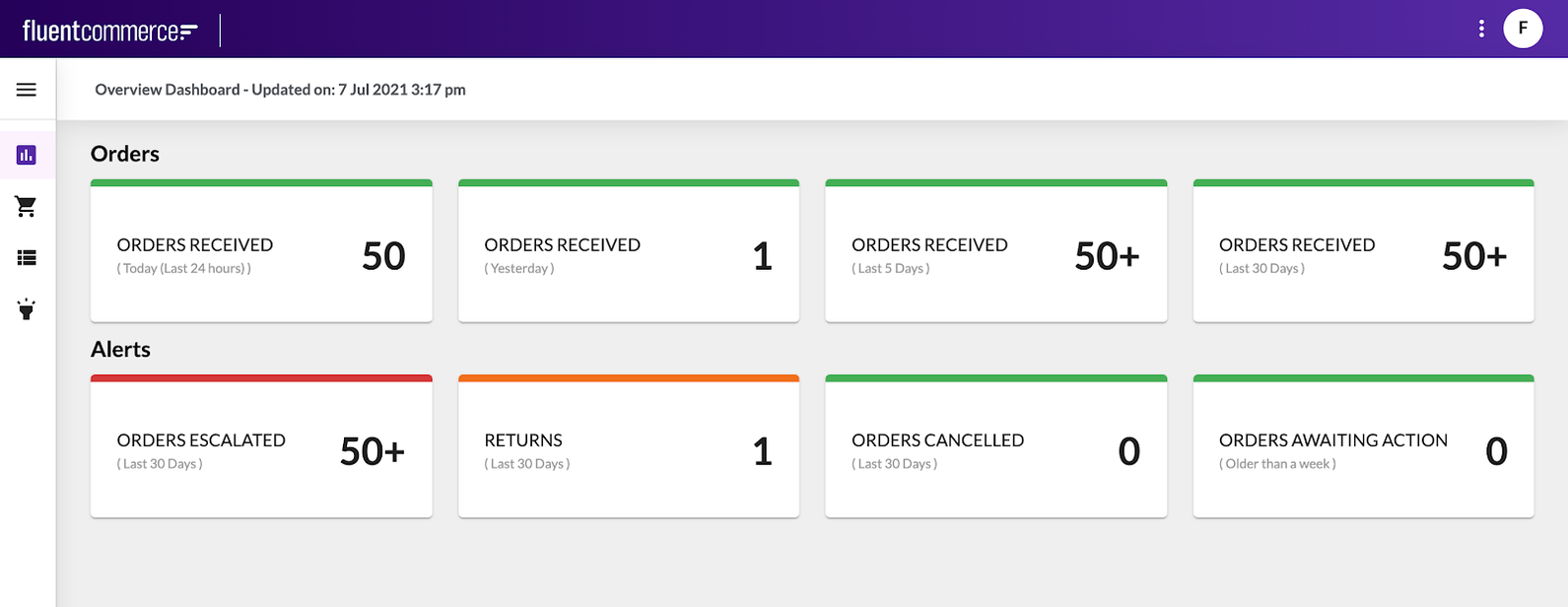
Orders Block
Displays the number of orders received during specific time frames:
- Today (Last 24 Hours)
- Shows orders received from the current time back to the same time yesterday.
- Clicking opens the Order List filtered to this time period.
- Yesterday
- Shows orders received between 24 and 48 hours ago.
- Clicking opens the Order List for this time range.
- Last 5 Days
- Orders received in the past five days.
- Last 30 Days
- Orders received in the past month.
All Orders block tiles are always Green when the number of orders equals or exceeds zero.
Alerts Block
Highlights operational issues and exceptions requiring attention:
- Orders Escalated (Last 30 Days)
- Orders with at least one fulfilment in Escalated status.
- Color coding:
- Green: < 1
- Orange: 1–10
- Red: > 10
- Returns (Last 30 Days)
- Return orders created in the last month.
- Color coding:
- Green: < 1
- Orange: 1–100
- Red: > 100
- Orders Cancelled (Last 30 Days)
- Orders cancelled within the last month.
- Color coding:
- Green: < 5
- Orange: 5–100
- Red: > 100
- Orders Awaiting Action (Older than a Week)
- Orders in PICK_PACK status for more than seven days.
- Color coding:
- Green: < 5
- Orange: 5–100
- Red: > 100
Related content
Order Management Interface
Author:
Fluent Commerce
Changed on:
19 Aug 2025
Overview
The Order Management interface is the central workspace for managing the order lifecycle. It brings together orders, customers, billing accounts, returns, and escalated fulfilments in one view. Orders provide access to details and fulfilments. Customers show records including accounts and order history. Billing Accounts manage financial operations such as invoices, memos, and payments. Returns track customer or system-initiated cases with refund details. Escalated Fulfilments highlight exceptions requiring action.
Key points
- The Order Management interface brings together orders, customers, billing accounts, returns, and escalated fulfilments in one place.
- It enables visibility and control over the entire order lifecycle, from creation through fulfilment, return, or escalation.
The Orders interface contains the Order List page, which displays orders from all retailers associated with the logged-in account. Access to the Order List is determined by assigned roles and permissions. The list includes order reference, customer name, type, status, value, and creation date, providing a complete view of order activity across the business.
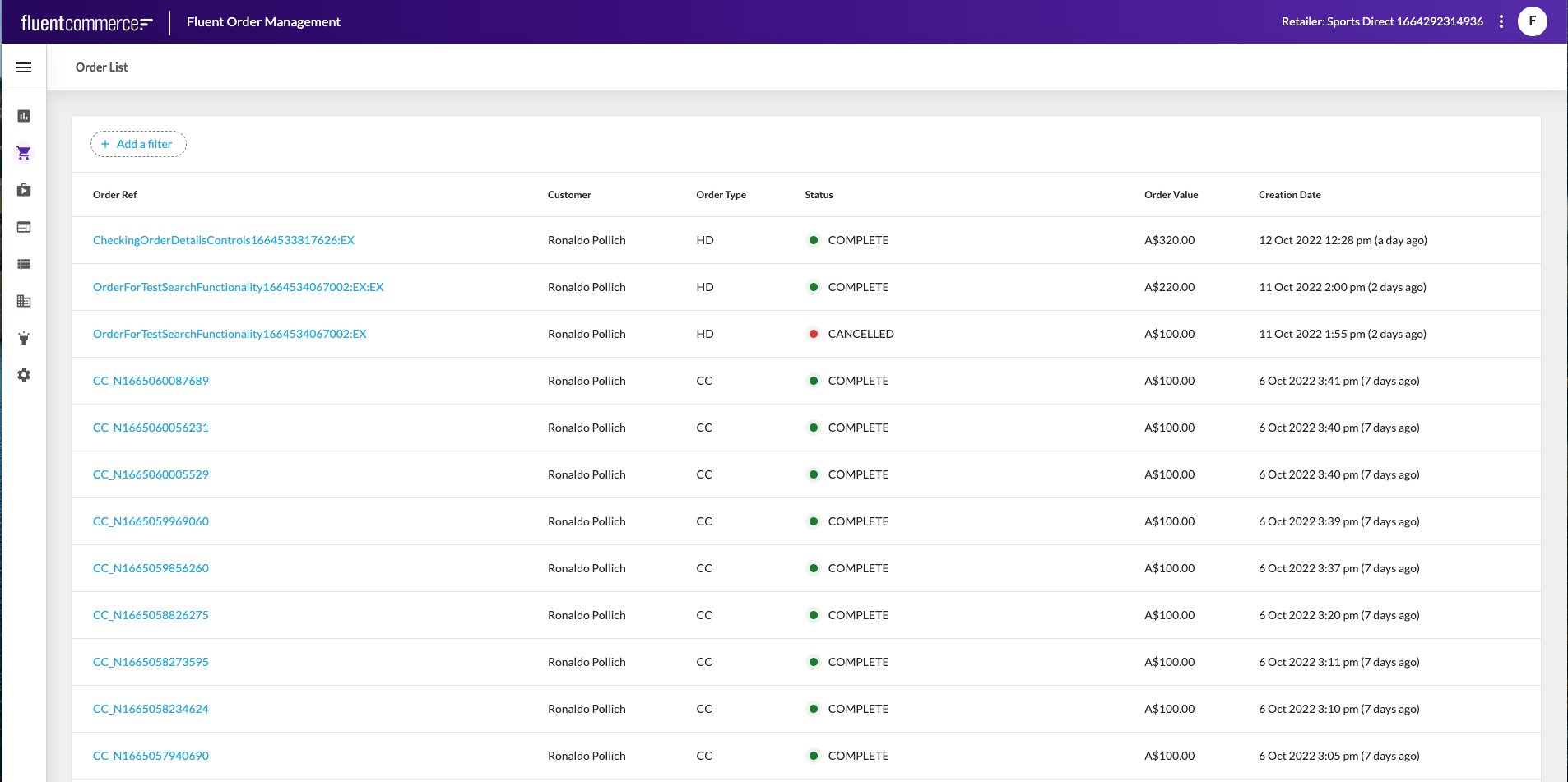
Clicking the Order Ref opens the Order Details page, which provides a comprehensive view of the selected order. This includes summary information, retailer details, customer details, collection or delivery information, fulfillments, order items, and additional tabs such as transactions, returns, comments, and activity.
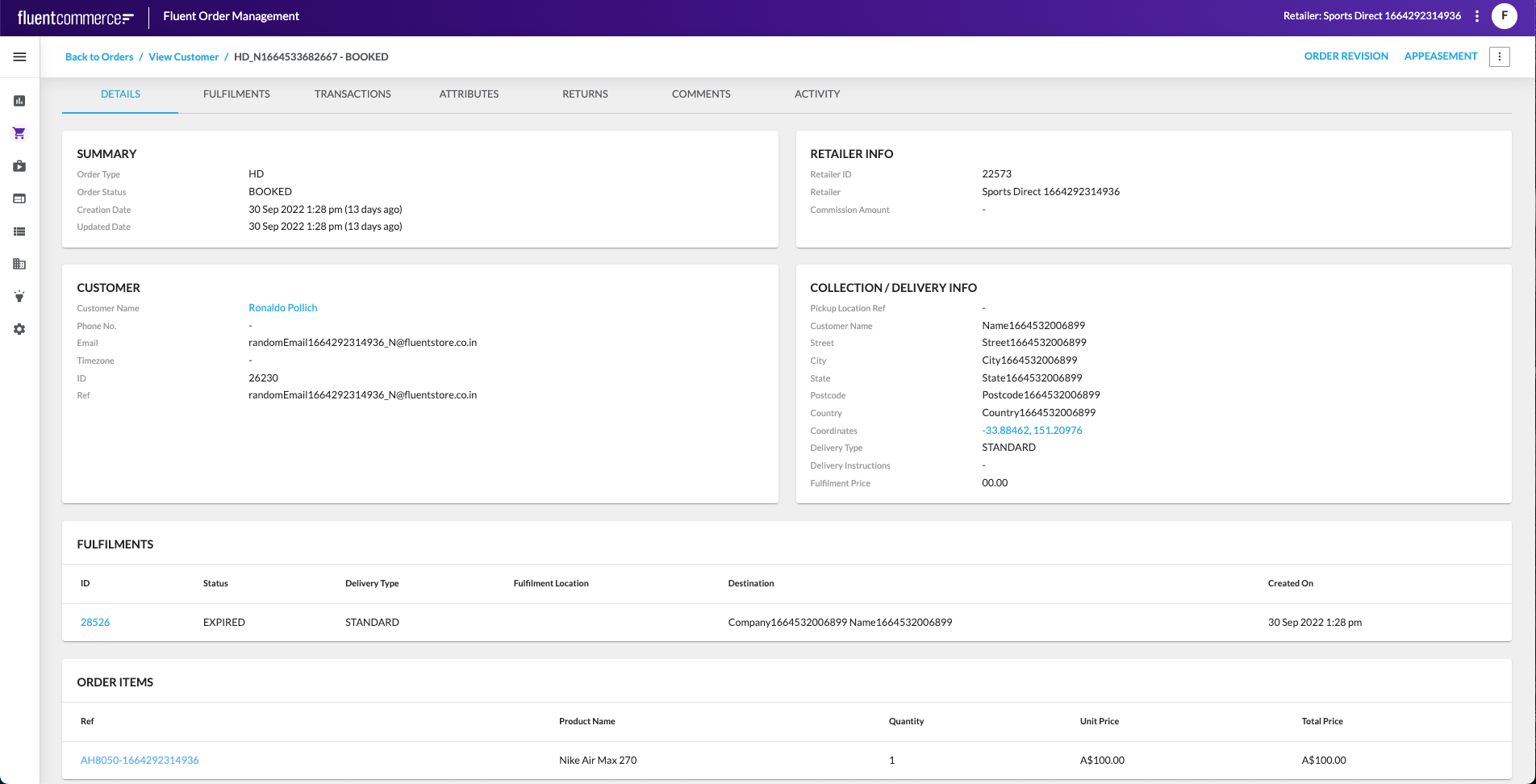
The Escalated Fulfilments interface provides visibility into fulfilments that could not be completed under normal processing rules. A fulfilment represents one or more items in an order that must be picked, packed, and delivered or collected. When items cannot be sourced or assigned according to retailer rules and available inventory, the fulfilment is moved into the `Escalated` state.
The Escalated Fulfilments page lists all fulfilments currently in the escalated state. This view enables quick identification of orders requiring further action or investigation.

Selecting a fulfilment opens the Fulfilment Details page, while selecting the related order reference opens the Order Details page. This allows direct navigation from the escalation record to the underlying fulfilment and order information.
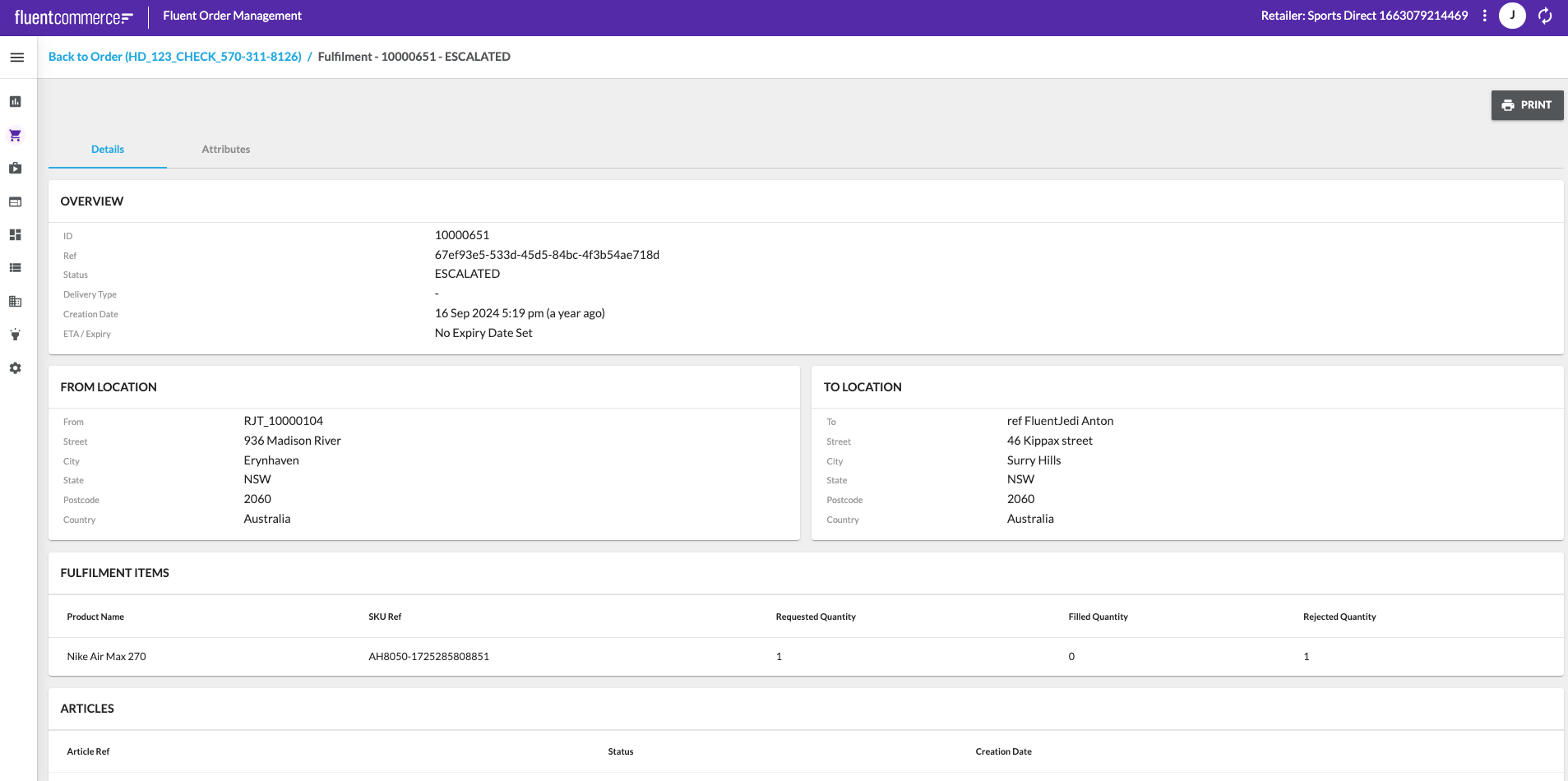
The Customers interface contains the Customer List page, which displays a list of all customers who have previously placed orders. This interface provides visibility into customer records within the Retailer, including the customer’s name, reference, contact details, timezone, and status. The list is essential for tracking customer information and for accessing related records such as billing accounts and order history.
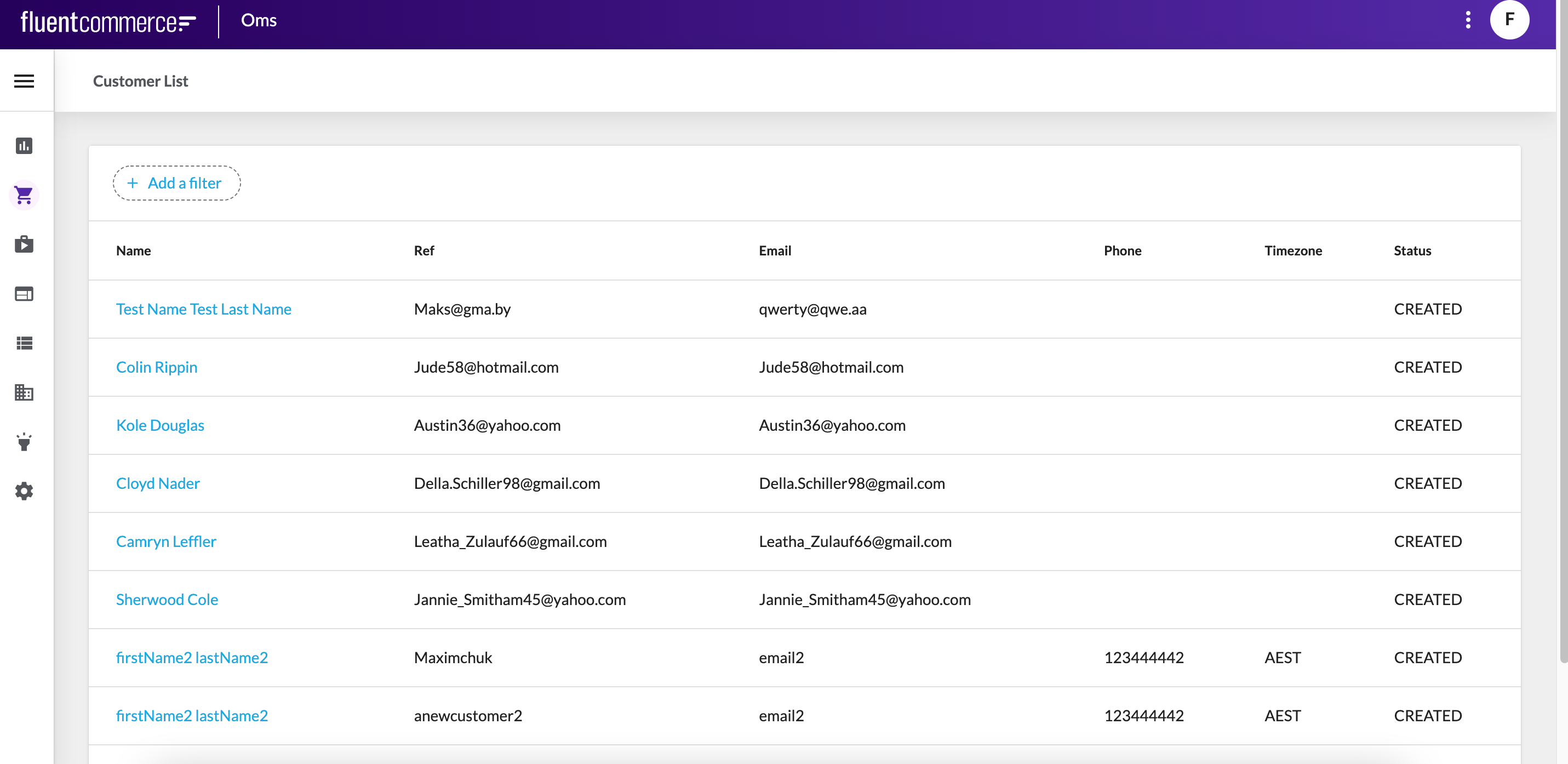
Clicking the Customer Name opens the Customer Details page, which displays detailed information about the selected customer, including personal information, account details, billing accounts, and order history.
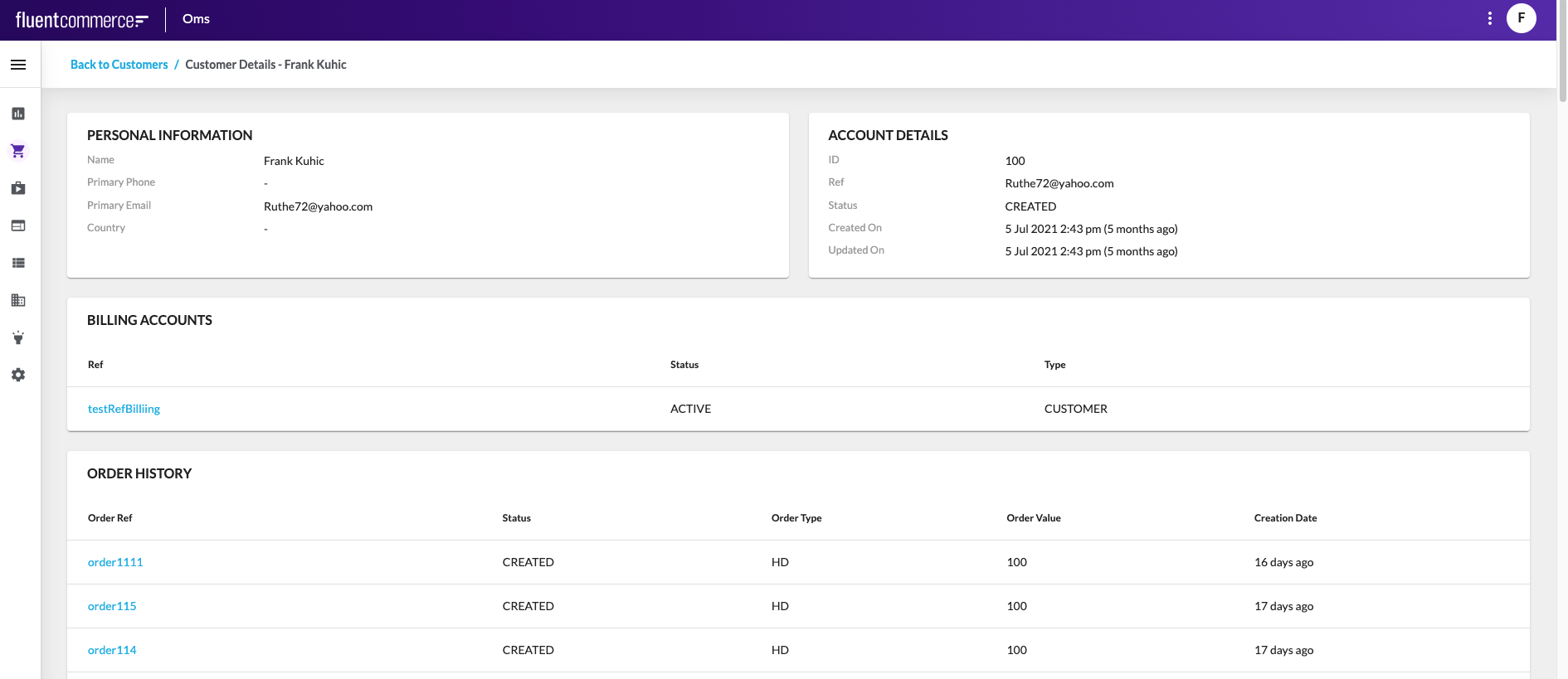
The Returns interface provides access to all customer returns across retailers linked to the logged-in account. A return represents a customer’s request to send back one or more items, or cases where items could not be fulfilled or were cancelled and require a refund.
Return records can exist with or without an original order reference. Where an order is linked, the return may include details such as items being returned, reasons, and refund information. Return types indicate the context of the return, such as customer return, cannot fulfil, or cancellation.
The Returns List page displays all returns permitted by the user’s roles and permissions. Returns can be searched and filtered to quickly locate relevant records. Each record includes a summary view of the return and provides navigation into more detailed information. Selecting a return opens the Return Details page.

The Return Details page provides a complete overview of a selected return. It includes summary information, addresses, associated fulfilments, returned items, additional attributes if defined, and an activity log. From here, it is possible to navigate back to the returns list or into related records such as orders, credit memos, or fulfilments.
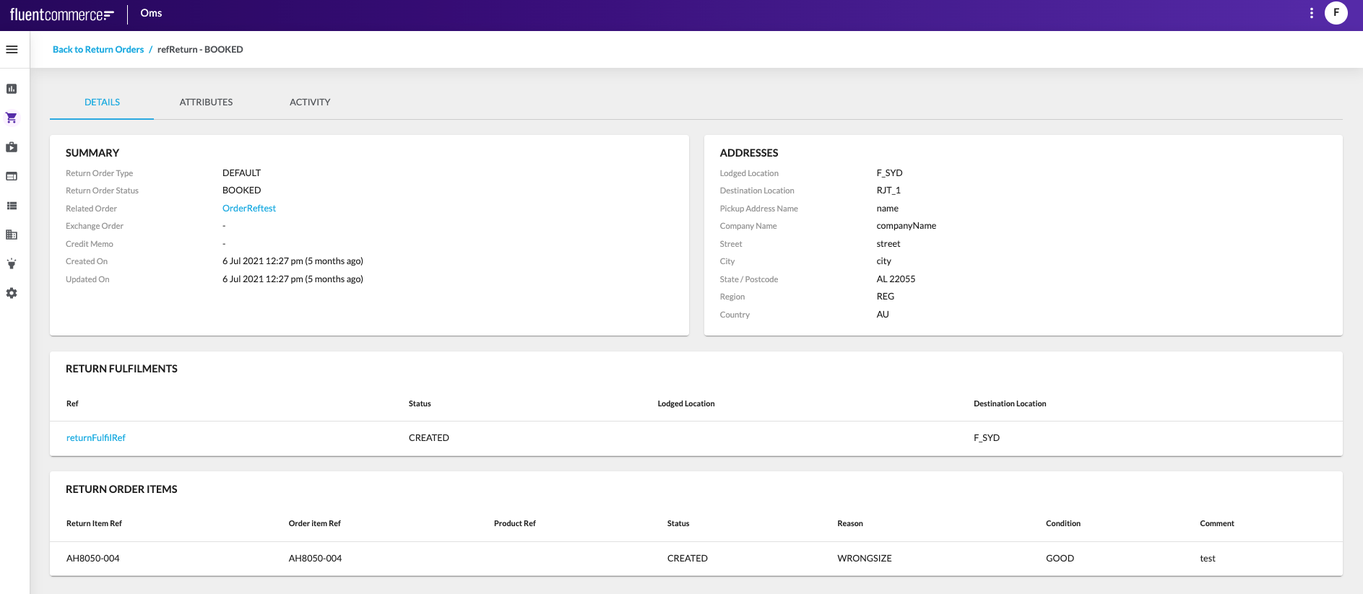
The Return Fulfilment Details page shows how a return is processed, including its references, locations, and current status. Navigation is available directly from the Return Details page by selecting a fulfilment from the Return Fulfilments section. This opens the fulfilment record, providing insight into where the return originated, where it is being sent, and how it progresses through its lifecycle.
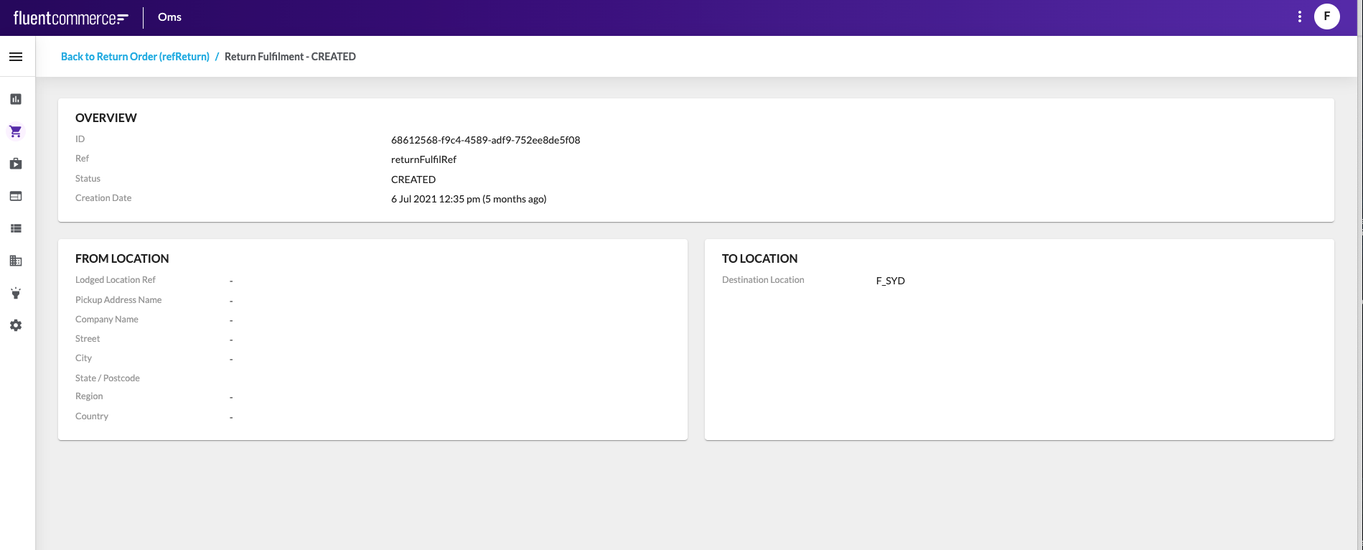
The Billing Accounts interface contains the Billing Account List page, which displays all created billing accounts. A billing account represents financial operations for a specific customer, including invoices, credit and debit memos, payments, invoice notifications, and ERP integrations. The list includes the account name, status, type, and reference, and provides direct access to detailed billing information.
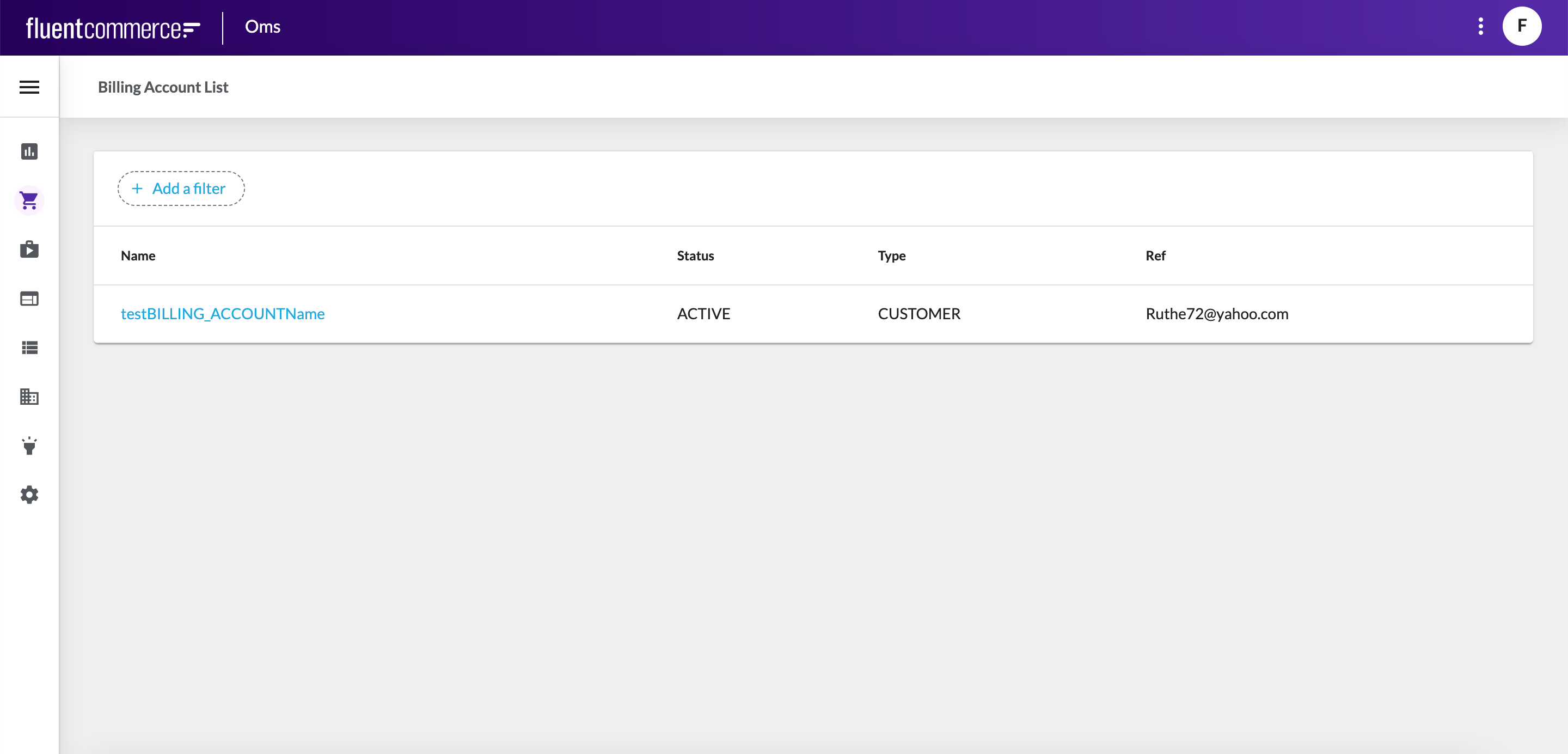
Clicking the Billing Account Name opens the Billing Account Details page, which provides a complete view of the selected account. This includes summary information, associated credit memos, custom attributes, and a record of all lifecycle activities.
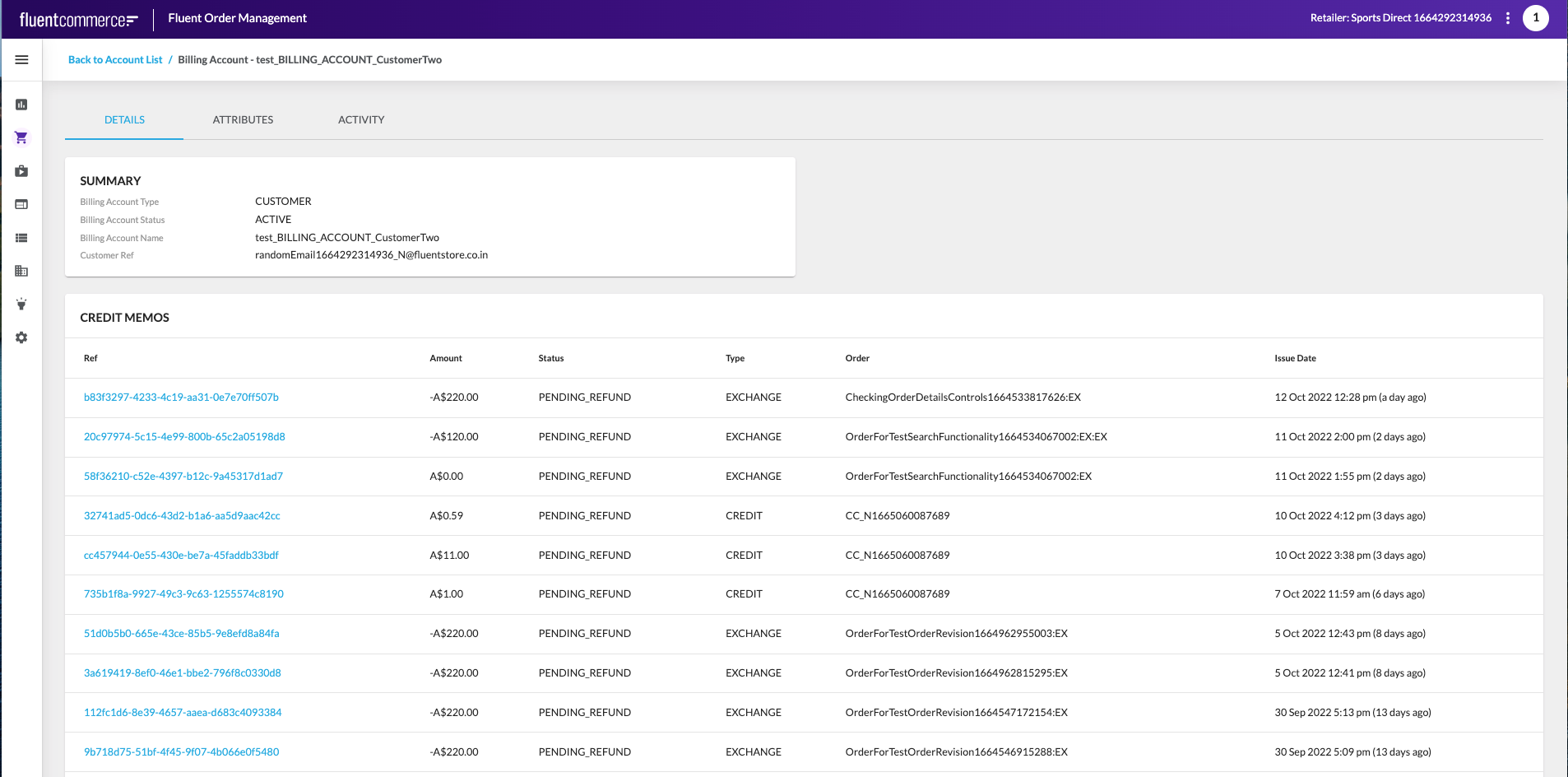
Availability Interface
Author:
Fluent Commerce
Changed on:
18 Aug 2025
Overview
The Availability interface provides visibility into fulfilment options generated by the system when evaluating how an order can be completed. Availability ensures that orders are processed in line with business rules, inventory availability, and delivery or collection methods.
The interface contains one submenu: Fulfilment Options. This section provides access to all generated fulfilment options and their related fulfilment plans.
Key points
- The Availability interface contains one submenu: Fulfilment Options.
- Fulfilment Options represent possible ways to complete an order, while Fulfilment Plans define the strategy behind each option.
- Together, these views provide oversight of how orders are fulfilled according to rules and inventory.
Fulfilment Options
The Fulfilment Options page lists all available options created for proposed or confirmed orders. Options represent potential ways an order can be fulfilled, including order type, status, and associated configuration details.

Selecting a fulfilment option opens the Fulfilment Option Details page. This view includes general details, addresses, linked fulfilment plans, products, and an activity log.
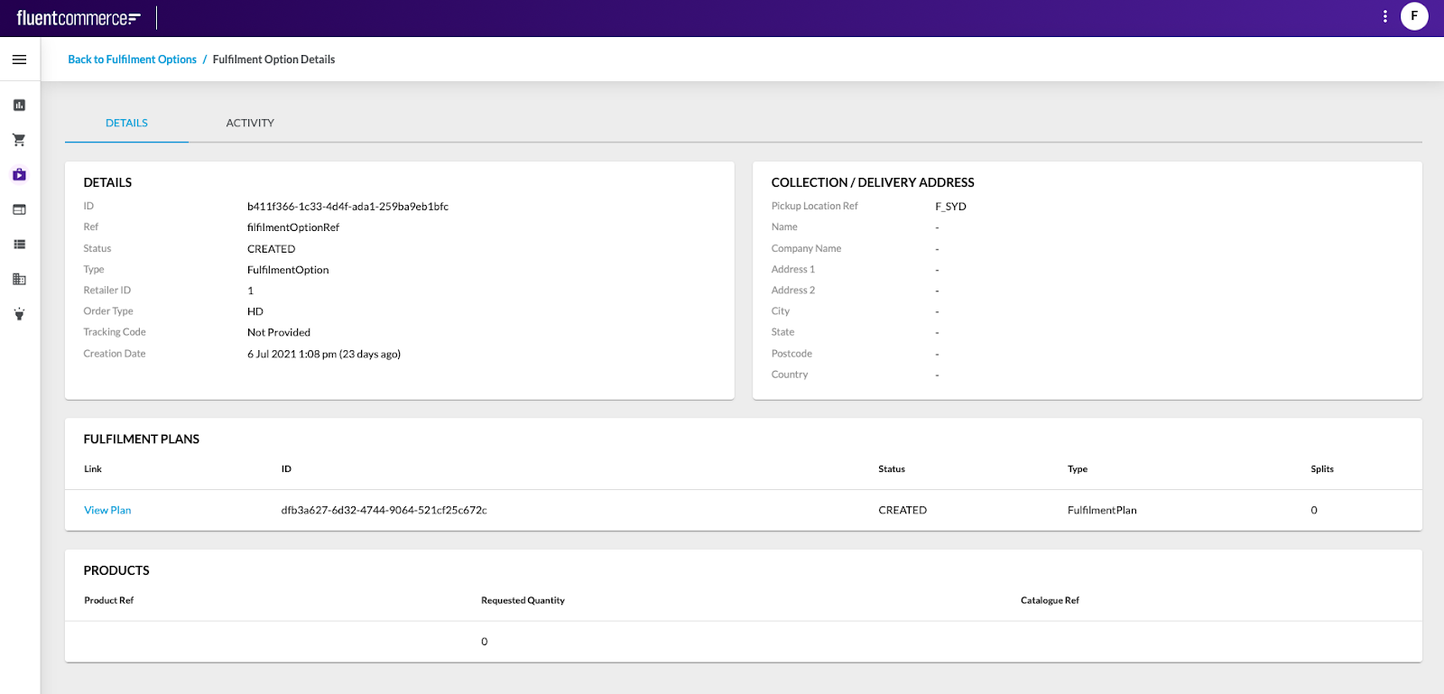
Fulfilment Plans
Each Fulfilment Option may include one or more Fulfilment Plans. A plan defines the strategy for completing the order, which may involve multiple fulfilments across different locations.
The Fulfilment Plan Details view highlights identifiers, estimated timings (e.g., ETA), fulfilment methods, and the associated fulfilments required to complete the order.
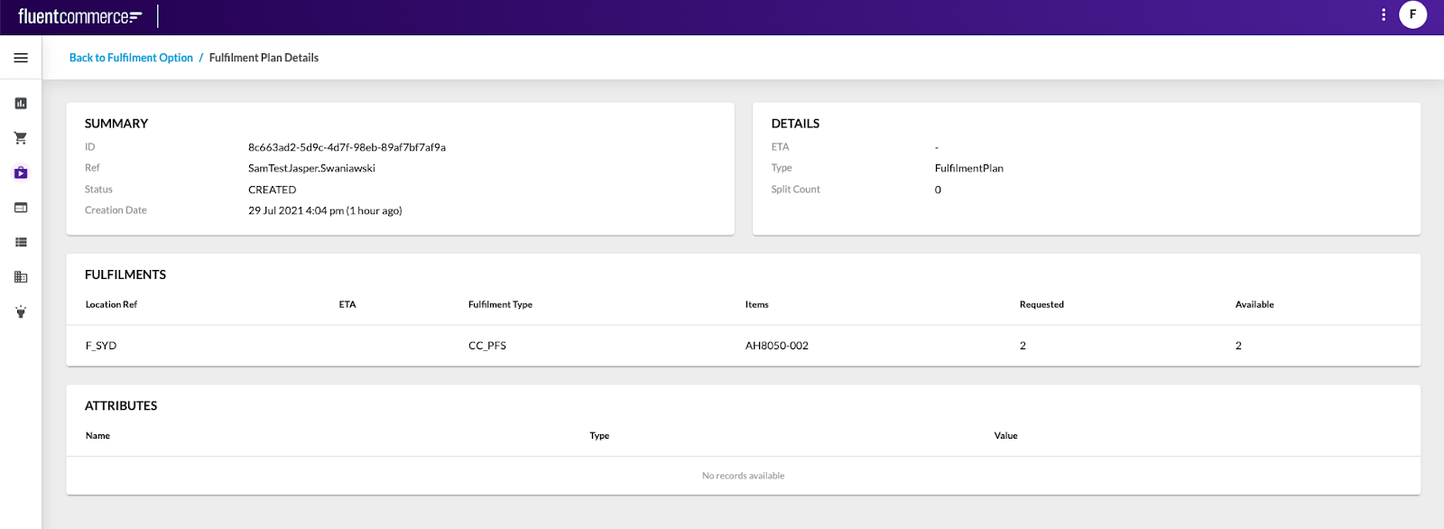
Related content
Products Interface
Author:
Fluent Commerce
Changed on:
30 July 2025
Overview
The Products interface is a collection of products and any attributes and details associated with each product in the category.
The Products interface of the Fluent Web App provides comprehensive capabilities:
- Product Catalog management
- Standard and Variant Product management
- Category management
The module contains the following configurations:
- Categories
- Product Catalogues
Key points
- The Products interface is a centralized hub for managing a collection of products, encompassing all associated attributes and details, offering a holistic approach to product management.
- It focuses on Product Catalog management, Standard Product management, and Category management. It empowers users to efficiently organize and oversee their product-related information, providing a seamless and comprehensive solution.
- The interface offers specific configurations for managing Categories and Product Catalogs, ensuring a tailored and effective product categorization and cataloging approach.
Categories
Products can be associated with categories and sub-categories.
The Categories page displays the list of all available categories. Clicking `Ref` opens the Product Catalogue Categories details page, which provides detailed information about the categories of a particular product catalogue.
The detail view consists of the following tabs:
- Details
- Attributes
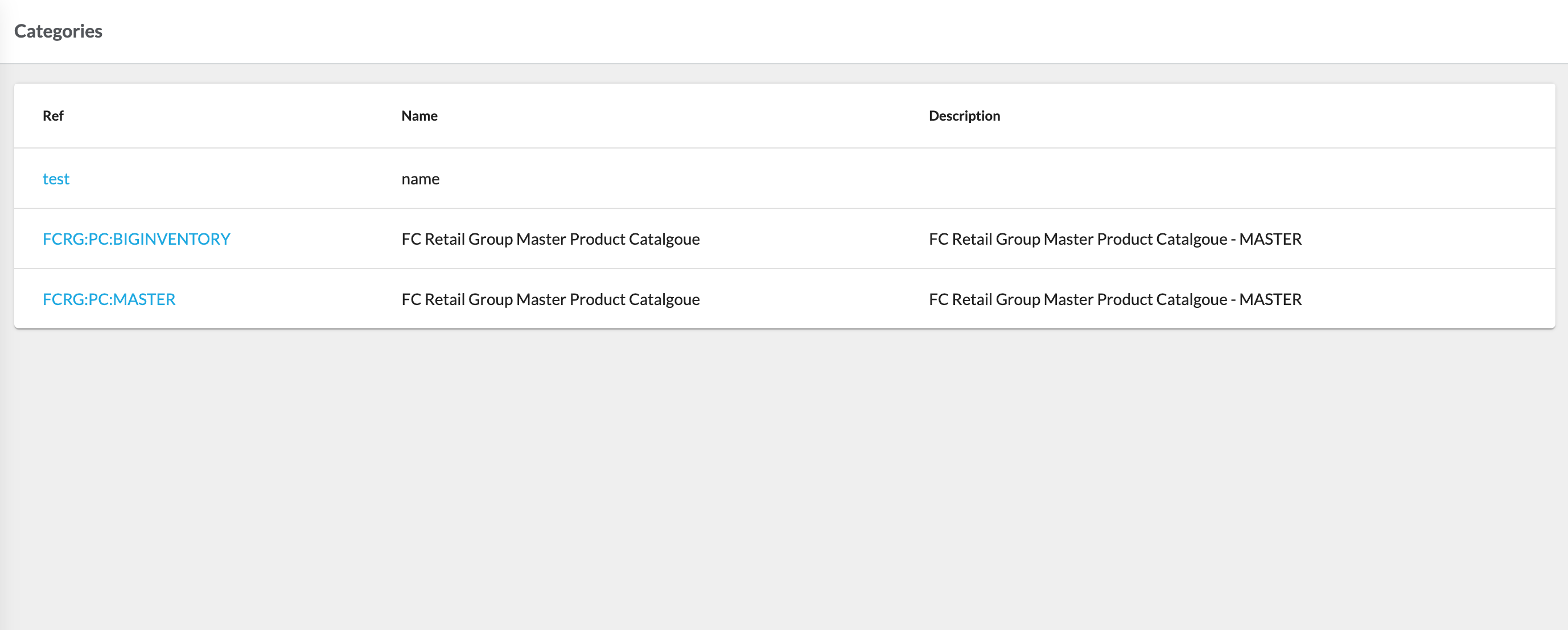

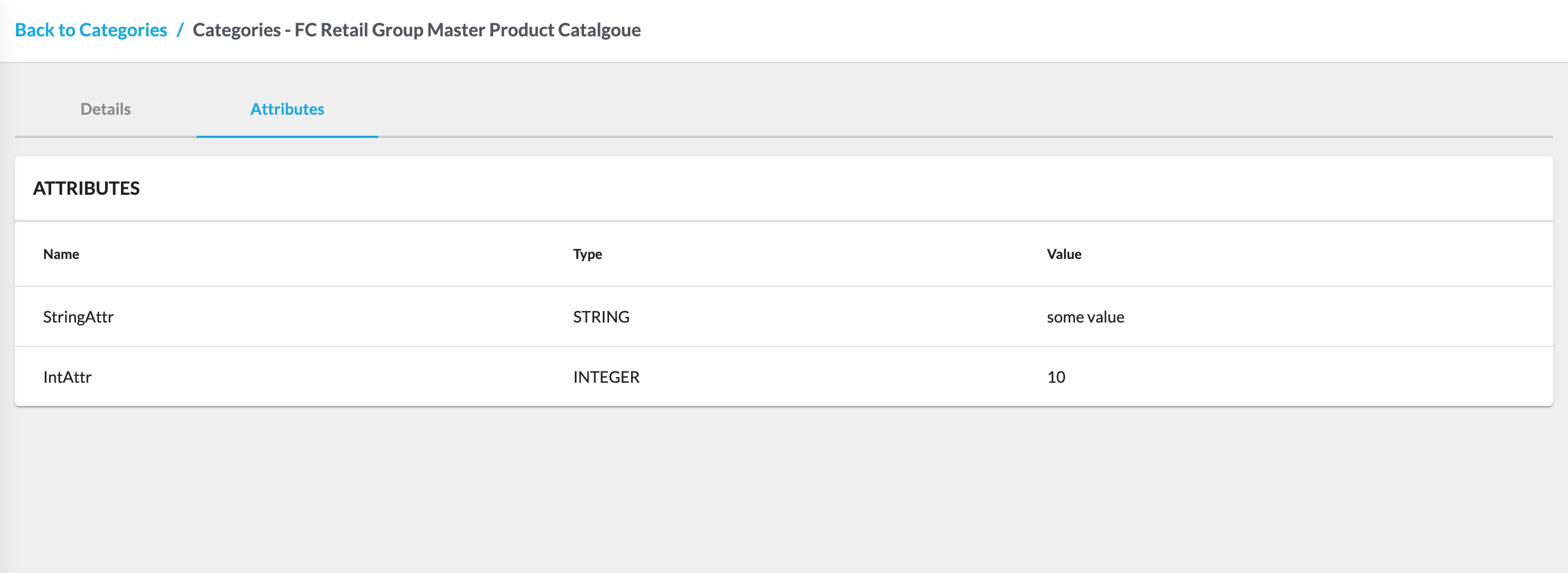
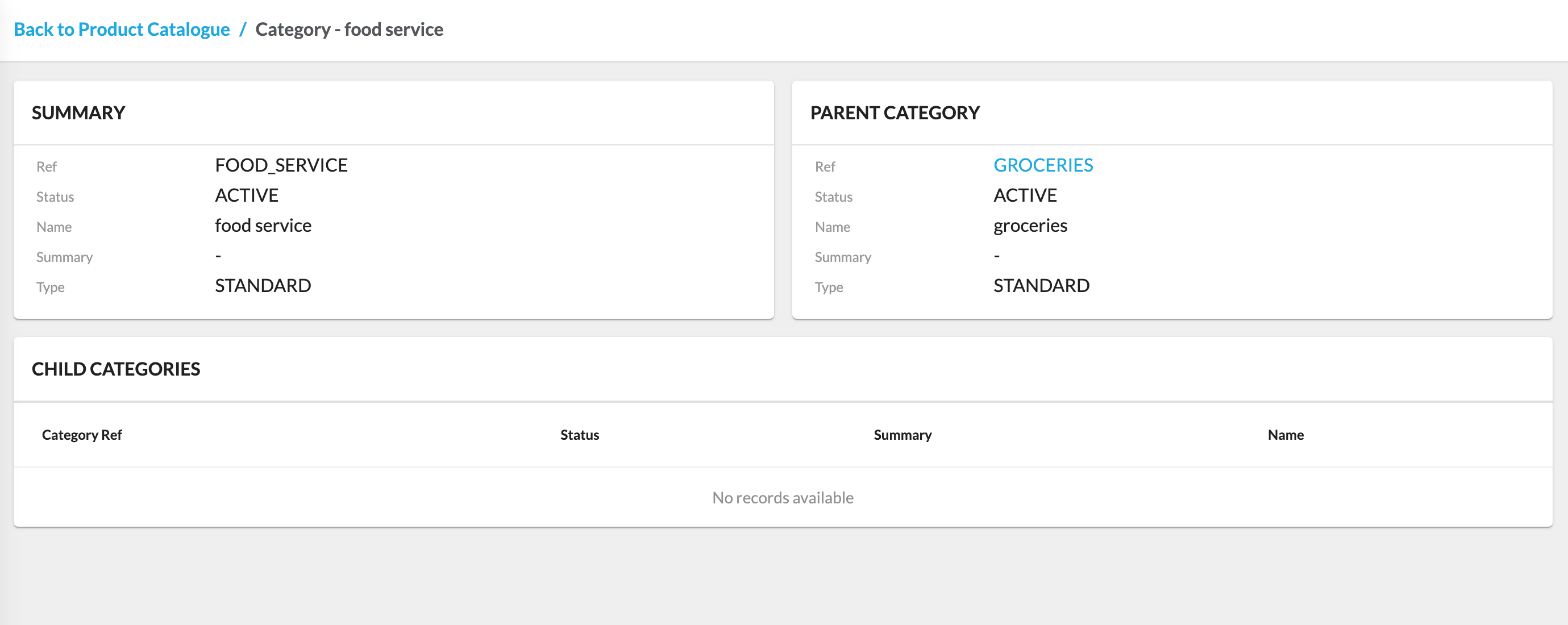
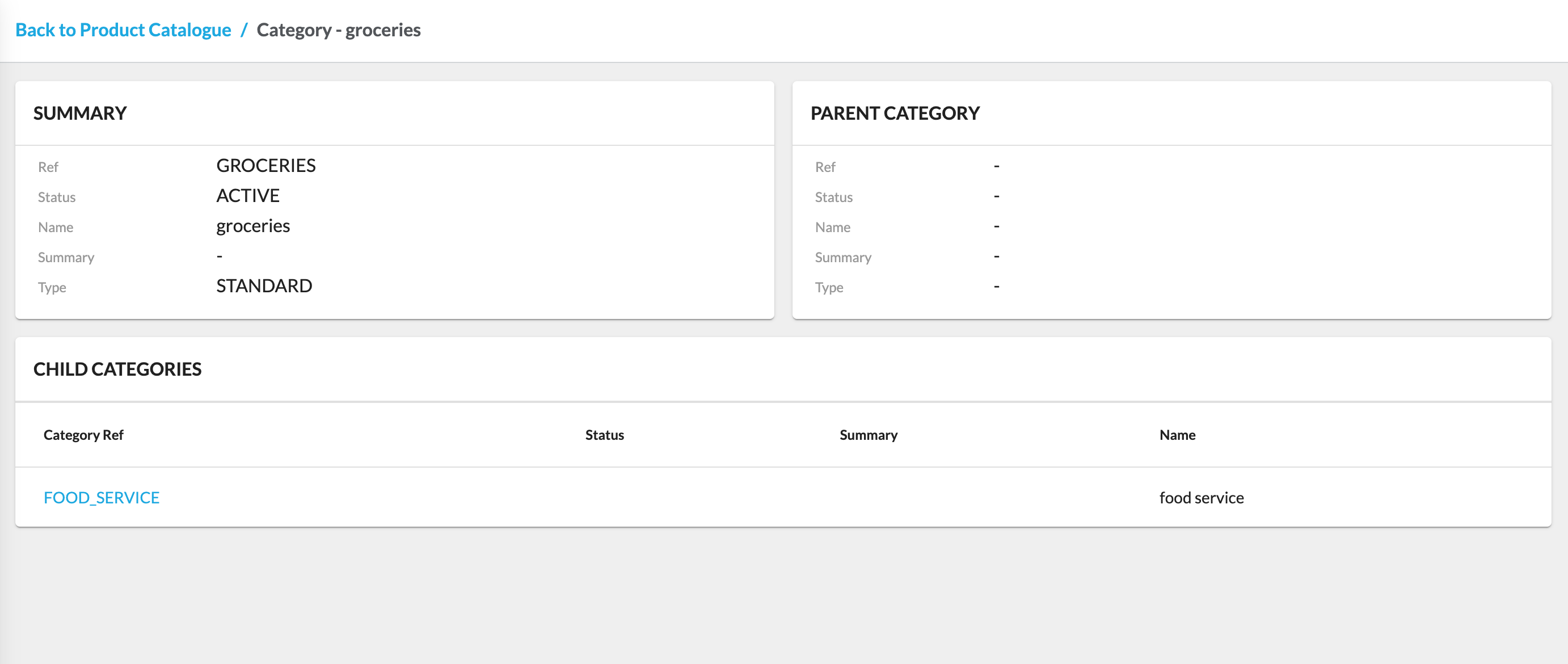
Product Catalogues
A Product Catalog stores all the Products a retailer wants to sell and contains information that helps identify each product (e.g., name, color, description, product code).
A retailer can have one or more Product Catalogs containing all its products. Each product catalog type has a corresponding workflow, referred to as a 'Product catalogue workflow,' which orchestrates products in the catalog. The retailer can configure workflows to add their specific business logic.
Product Catalog Entities
- Standard Product
- A standard product entity. It includes:
- a sellable, non-variant product
- a non-sellable base for a variant product
- a sellable or non-sellable component of a group product
- A standard product entity. It includes:
- Variant Product
- An entity that holds additional attributes for variation of a base product, such as size, color, volume, etc. The base product is non-sellable and stored as a Standard Product.
The Product Catalogues configuration displays the list of all available product catalogues. Clicking `Ref` opens the Product Catalogue details page, providing detailed information about the product catalogue.
The detail view consists of the following tabs:
- Details
- Categories
- Attributes
- Activity
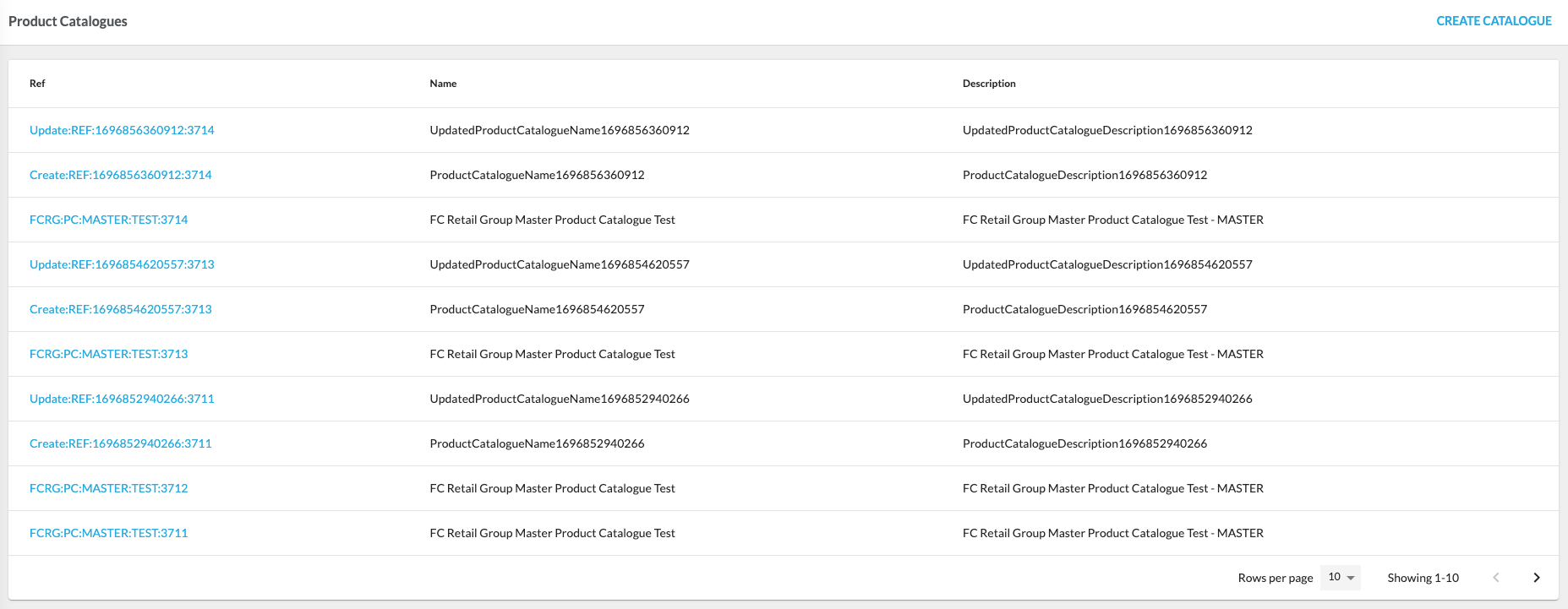
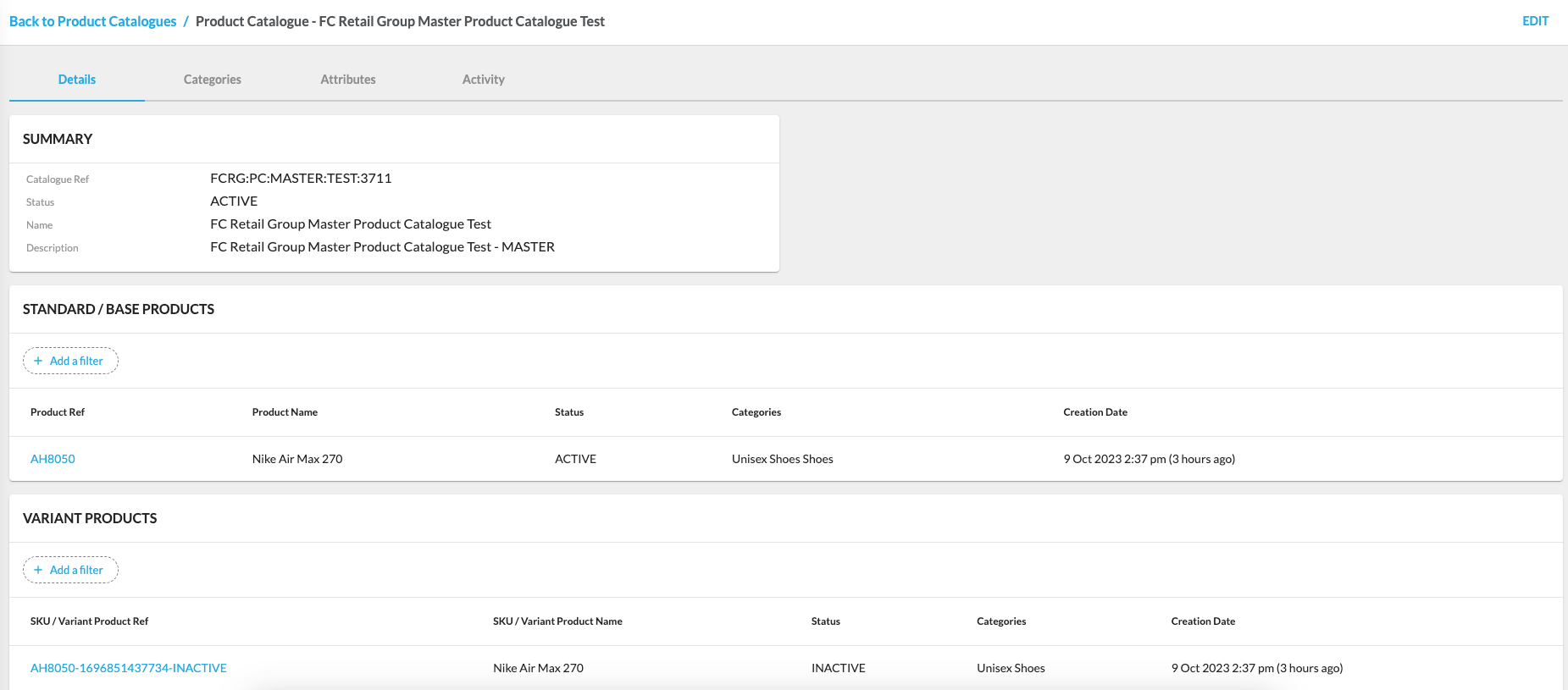


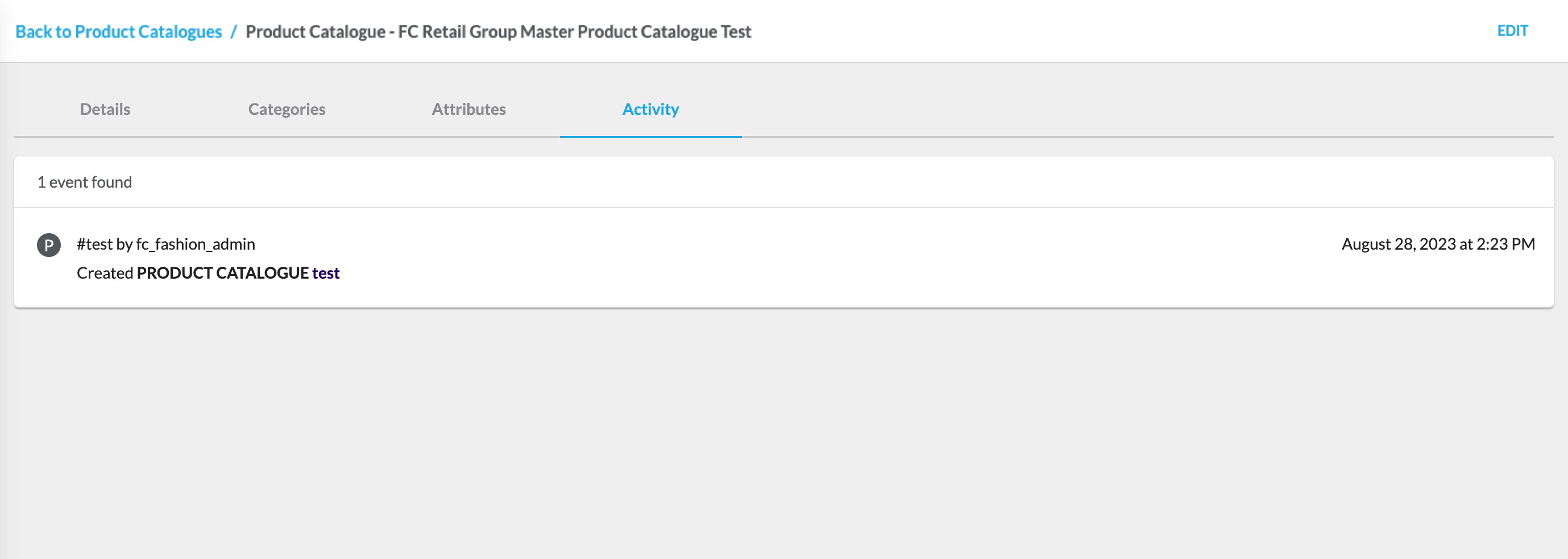
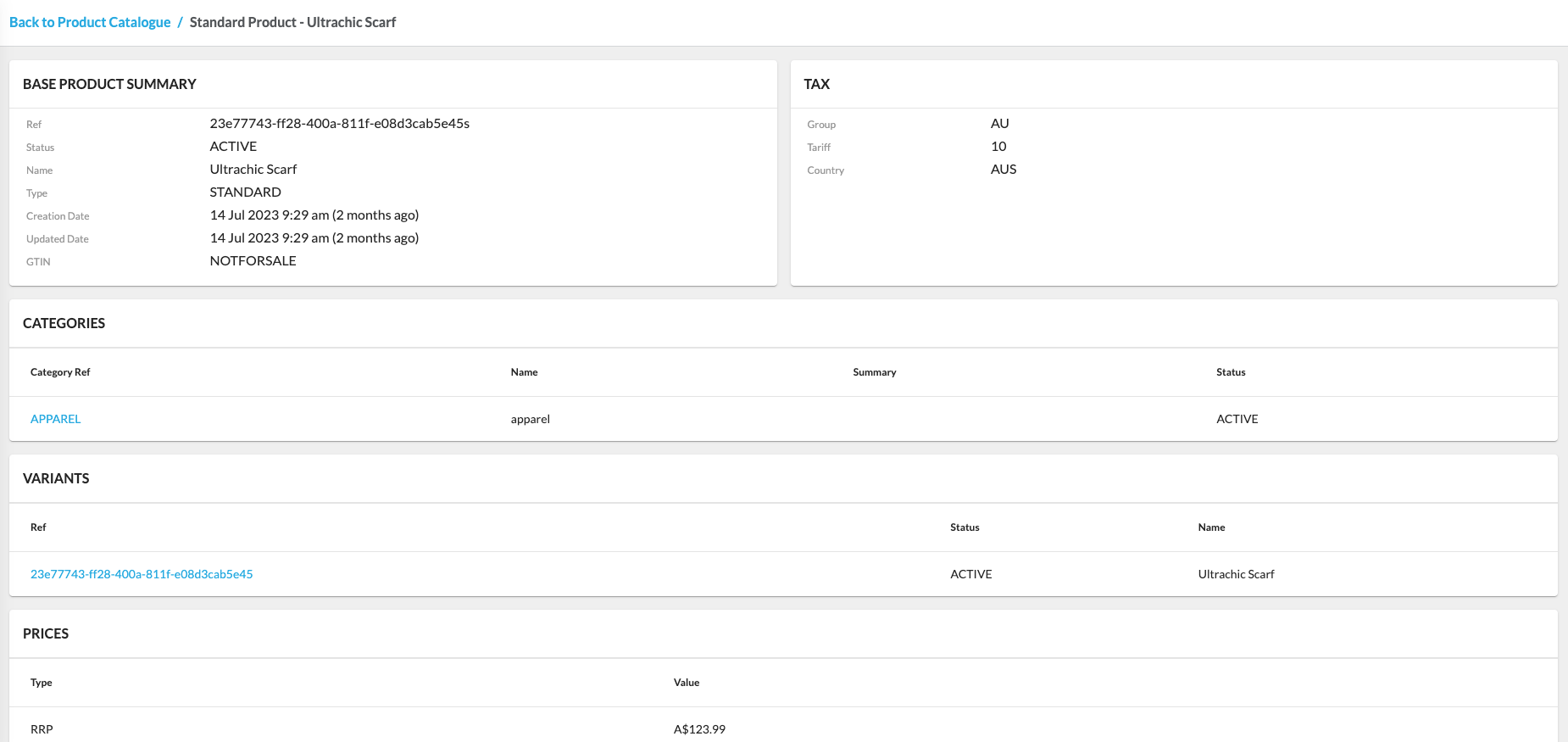

Features
The Products Section offers a set of features designed to help users efficiently manage products within the application.
Manage Product Catalogs
Users can create and manage product catalogs within the Products Section to organize and maintain product information effectively.
For step-by-step instructions on creating and editing product catalogs, refer to the guide:
Related content
Unified View of Inventory Interface
Author:
Yulia Andreyanova
Changed on:
29 Aug 2025
Overview
The Unified View of Inventory (UVOI) interface consolidates data from multiple locations and channels into a single, real-time interface. It provides centralized inventory search, advanced filtering, and customizable views. It enables you to monitor, analyze, and act on inventory data.
Key points
- Centralized Inventory Management: The Unified View of Inventory (UVOI) consolidates data from multiple locations and channels into a single, real-time interface, simplifying inventory management and improving decision-making.
- Advanced Filtering Capabilities: UVOI offers flexible filters for refining search results, including catalog, stock status, on-hand quantities, and product or location-specific criteria.
- Comprehensive and Customizable Views: The Inventory Search page provides a detailed overview of inventory, with drill-down capabilities for stock levels, available-to-sell quantities, and update histories. Users can navigate to location-specific or product-specific views and customize filters and criteria to tailor the experience to their operational needs.
The Unified View of Inventory (UVOI) interface offers an intuitive interface tailored to your needs. It empowers you to access, analyze, and act on real-time inventory information without complexity.
In this document, you will explore:
- Inventory Search Page: A centralized view with filter panels to refine inventory and virtual positions.
- Advanced Filtering Capabilities: Filters for catalog, stock status, on-hand quantities, and more.
- Inventory View by Location: Detailed insights into inventory at specific locations. Including stock levels and virtual positions.
- Inventory View by Product: A comprehensive look at product-specific inventory across locations, with key product details and statuses.
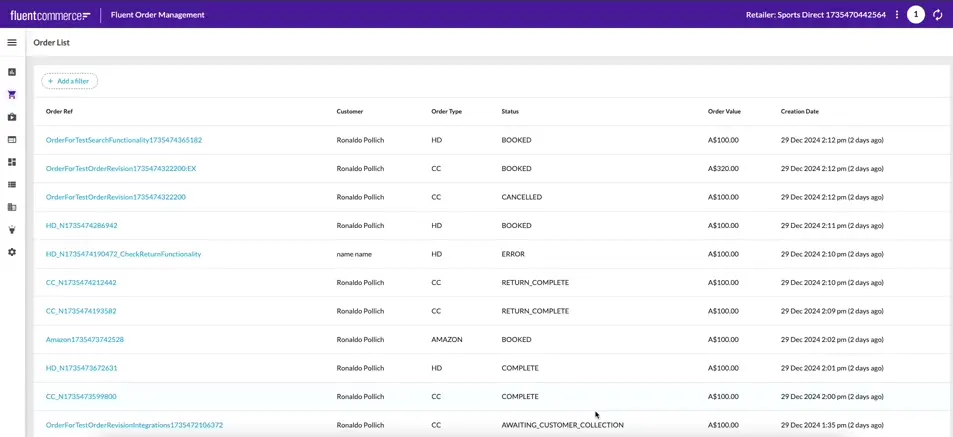
Inventory Search Page
The UVOI comes with a new menu section that is available out of the box in the Fluent OMS and Fluent Big Inventory Web Apps. The Inventory Search page displays a filter panel and a list of inventory positions as search results. Each inventory position expands into a detailed list of associated virtual positions, accessible via a dropdown.
The top filter panel refines inventory positions based on user-defined criteria, while the inner filter panel focuses on virtual positions. These two filter panels operate independently.
Advanced Filtering Capabilities
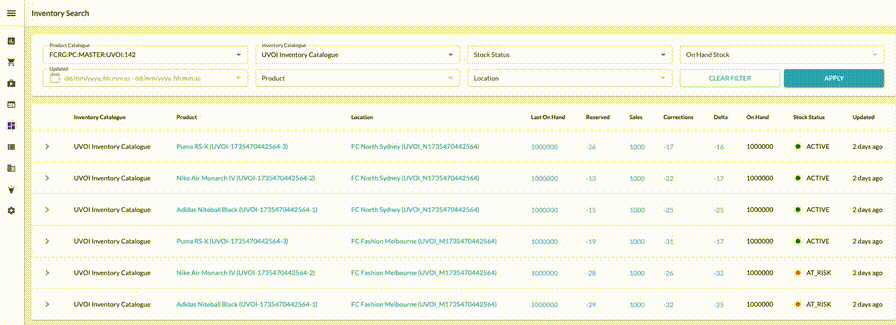
The Unified View of Inventory offers powerful and flexible filters to refine search results:
- Product Catalog Filter automatically applies the default product catalog upon visiting for the first time, as configured via the fc.oms.inventory.search.product.catalogue.default setting. The selected product catalog determines the product name displayed in the search results table. If the product associated with an inventory position belongs to a different product catalog, the product name will not appear. Instead, only the product reference will be shown.
- Inventory Catalog Filter controls the records displayed by linking to the inventory catalog defined via the fc.oms.inventory.search.inventory.catalogue.default setting. If no default inventory catalog is set, no records will appear.
- Stock Status Filter filters inventory positions by status as defined in the setting.
- OnHand Stock Filter allows filtering based on available on-hand stock. Users can set a range or filter inventory with values greater or smaller than a specific threshold.
- Updated Filter enables filtering by the last update timestamp of inventory positions.
- Product and Location Filters refine inventory positions by product or location. Clicking the filter opens an advanced form where users can search by name or reference. Matched records appear as selectable chips.
Once filters are applied, the panel updates the results to display only the inventory positions matching the selected criteria.
Inventory Position Details
The Inventory Search page presents a detailed overview of inventory positions, offering important information at a glance. Users can view the inventory catalog name, associated product, and location, along with calculated on-hand quantities and aggregations of inventory quantities. Additionally, it displays the stock status and timestamps for the most recent updates, ensuring complete visibility into inventory changes.

Clicking any quantity cell opens a Type History Drawer, displaying the history of changes for that inventory quantity type.
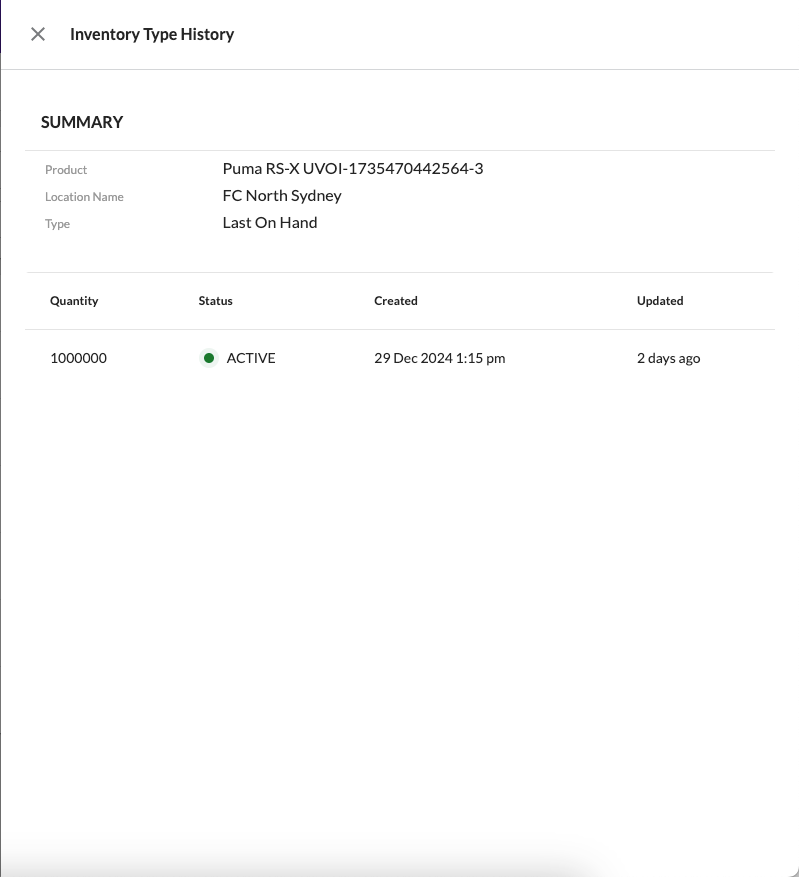
Each inventory position contains an inner list of associated virtual positions, enabling a more granular view of inventory filtering by virtual catalog, available stock, and virtual stock statuses.

From an inventory position, users can navigate to detailed inventory views:
- By Location: Focuses on inventory specific to a chosen location.
- By Product: Displays inventory details for a specific product, including stock levels across locations and virtual positions.
Both pages carry over filters from the main search but exclude inner filter settings for virtual positions.
Inventory View by Location
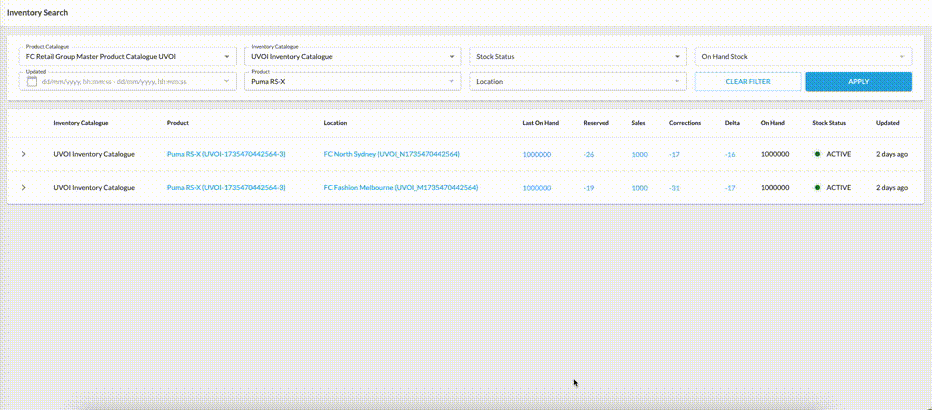
The Inventory View by Location page gives a clear and detailed look at a specific location’s inventory. Users can click on a location name from the Inventory Search page to access this view. The location reference will still show if someone doesn’t have the required permissions, but it won’t be clickable, keeping restricted information protected.
This page provides the location’s address, working hours, and a full list of inventory positions. It also includes a filter panel—without the location filter—and a detailed inner list of virtual positions linked to each inventory entry. This ensures that all the key inventory details for that location are easy to find.
Filters from the Inventory Search page carry over to this detailed view, making it easier to continue working with the same data. However, filters from the inner list do not apply. A breadcrumb link at the top allows users to return to the Inventory Search page, keeping any previously applied filters in place, even when switching between different details pages.
Inventory View by Product
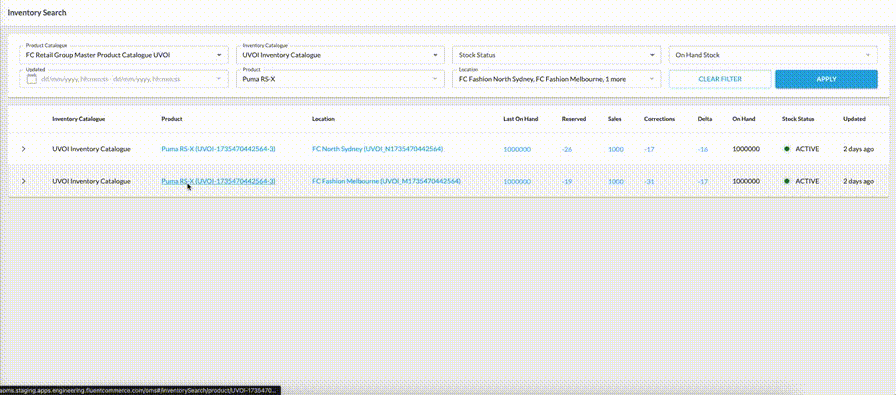
The Inventory by Product page provides a detailed view of inventory information for a specific product. Users can click on the product name from the Inventory Search page to access this page. If the selected product catalog is incorrect or doesn’t include the product, navigation to the product’s details will be restricted, and only the product reference will be displayed without a clickable link.
On the UVOI by Product page, users can see key product details, such as its name, status, category, and description, along with an image of the product. The page also features a filter panel—excluding the product filter—and an updated list of inventory positions, complete with their associated virtual positions.
Filters applied on the Inventory Search page remain active on this page, helping users maintain their focus on relevant data. Inner list filters, however, do not carry over. A breadcrumb navigation link allows users to return to the Inventory Search page with their original filters preserved, even when moving between multiple details pages.
Optimizing Stock, Enhancing Experiences
By combining advanced filtering capabilities, real-time updates, and intuitive navigation, UVOI ensures that users—from retail managers to eCommerce teams—can easily make data-driven decisions.
Whether you're monitoring stock by location or tracking inventory across sales channels, UVOI empowers businesses to maintain optimal stock levels, reduce inefficiencies, and enhance the customer experience.
Related content
Inventory Interface
Author:
Fluent Commerce
Changed on:
29 Aug 2025
Overview
The Inventory interface of the Fluent Web app provides comprehensive inventory management capabilities:
- Inventory visibility
- Inventory allocation
- The total quantity of stock for a specific item (stock on hand(SOH)) and the status of that inventory
- Available to promise inventory levels
- Inventory buffers to reduce overselling of products
Key points
- The Fluent Web app's Inventory interface offers a comprehensive suite of capabilities, including inventory visibility, allocation, total stock quantity (stock on hand), inventory status, available-to-promise levels, and strategically implemented buffers to prevent product overselling.
- The interface is equipped with various configurations, such as Inventory Catalogues, Control Groups, Virtual Catalogues, Cross-Catalogue Views, and Location Inventory Views, providing users with versatile tools to tailor their inventory management approach according to specific business needs and scenarios.
The interface contains the following configurations:
- Inventory Catalogues
- Control Groups
- Virtual Catalogues
- Cross-Catalogue Views
- Location Inventory Views
Inventory Catalogues
An Inventory Catalogue consists of inventory positions that can be aggregated from multiple sources. Inventory catalogues hold stock on hand (SOH) of products, variants, and groups. The Inventory Catalogues configuration allows users to create and manage inventory catalogues.
Inventory Catalogue configuration contains the list of inventory catalogues for a particular retailer. Clicking `Catalogue Ref` opens the Inventory Catalogue Details page, which displays detailed information.




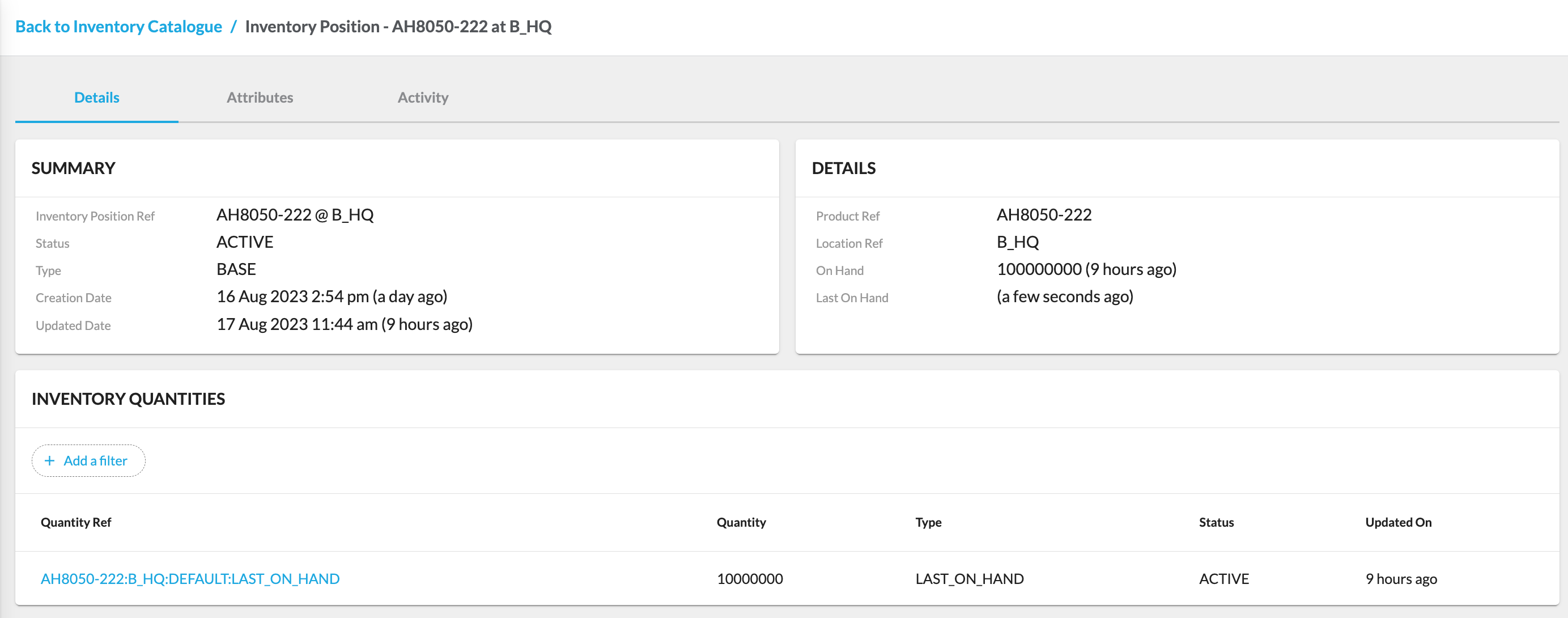
Control Groups
Control Groups manage buffers and safety stock when providing virtual inventory to sales channels.
Control Groups configuration contains the list of control groups for a particular retailer. Clicking `Ref` opens the Control Group Details page, which displays detailed information about the Control Group and its Controls.



Virtual Catalogues
Virtual Catalogues represent fast-moving dynamic data such as buffered inventory and multiple dynamic inventory counters. A Virtual Catalogue commonly consists of virtual positions based on products in a location, products in a network, and products in a category based on the requirements of retailers.
Virtual catalogue configuration contains the list of virtual catalogues for a particular retailer. Clicking `Ref` opens the Virtual Catalogue Details page. The Virtual Catalogue Details page details the specific virtual catalogue and its virtual positions.




Cross-Catalogue Views
Cross-Catalogue Views represent displaying information from the cross-catalogue perspective (Virtual Catalogue, Inventory Catalogue, and Control Group) for a particular retailer.

Location Inventory Views
Location Inventory Views represent inventory from a location perspective. The Location Inventory Views page displays the list of locations.


Features
The Inventory interface provides several features that allow to manage inventory efficiently.
Manage Control Groups
Control Groups represent the collection of controls for a particular Virtual Catalogue. As standard, a Control Group is created for each Virtual Catalogue with the Control Group reference added to the `controlGroupRef` field of the Virtual Catalogue it is associated with.
A Control represents a specific value to be applied as part of a Virtual Position's AVAILABLE TO SELL calculation. Controls can be of multiple types, each determining how the control is applied and to what Virtual Positions. These can be prioritized to be calculated in specific orders or instead of other Controls.
For more details about the specifics of creating and editing Control Groups, check out the following guide.
Manage Virtual Catalogues
The Virtual Catalogue configuration allows users to create and manage virtual catalogs.
For more details about the specifics of creating and editing virtual catalogs, check out the following guide.
Manage Inventory Catalogues
The Inventory Catalogue section allows users to create and manage inventory catalogs.
For more details about the specifics of creating and editing inventory catalogs, check out the following guide.
Related content
Store Interface
Author:
Fluent Commerce
Changed on:
27 Aug 2025
Overview
The Store interface empowers retailers to enhance their operational efficiency by transforming stores into fulfillment centers and optimizing inventory management. This ultimately delivers a superior customer experience through streamlined order fulfillment and improved inventory control.
The app contains the following configurations:
- All Locations
- Stores
- Warehouses
- Networks
Key points
- Stores are transformed into efficient fulfillment centers, ensuring a seamless customer experience through optimized order fulfillment and superior inventory control.
- With configurations for all Locations, Stores, Warehouses, and Networks, the app provides a comprehensive toolkit, enabling retailers to manage their entire ecosystem.
Features
Location Overview and Detailed Information
- Get a comprehensive view of all physical locations within your retail ecosystem.
- Access in-depth details about each location, such as location-specific information, opening hours, and a convenient "Location Finder" tool for easy navigation.
- Understand the operational status of each location while efficiently organizing them into logical networks, allowing for informed decision-making regarding order fulfillment and customer collection.
- Efficiently manage storage areas within your locations to optimize inventory control, enabling precise allocation and tracking of items for enhanced order fulfillment and storage efficiency.
Store and Warehouse Details
- Access specifics about your stores and warehouses, including information on the networks they belong to, storage areas, schedules, and order processing waves.
- Utilize stores as inventory sources for fulfilling customer orders while ensuring that these locations are not only for collections but also as integral parts of your supply chain.
Networks
- Organize your locations into logical or geographic categories known as networks, simplifying management and optimization efforts.
- Access comprehensive data about your networks, including network attributes, locations, and affiliated retailers.
A location is a physical place that serves as a hub for shipping and receiving items you're selling. These can include warehouses, retail stores, and third-party vendor facilities, which play a crucial role in your supply chain. In the Locations interface, you can access the Locations List page, which presents the catalogue of existing locations. If you want to delve deeper into a particular location's specifics, click on `Location Ref` to open the Location Details page, providing a comprehensive overview.

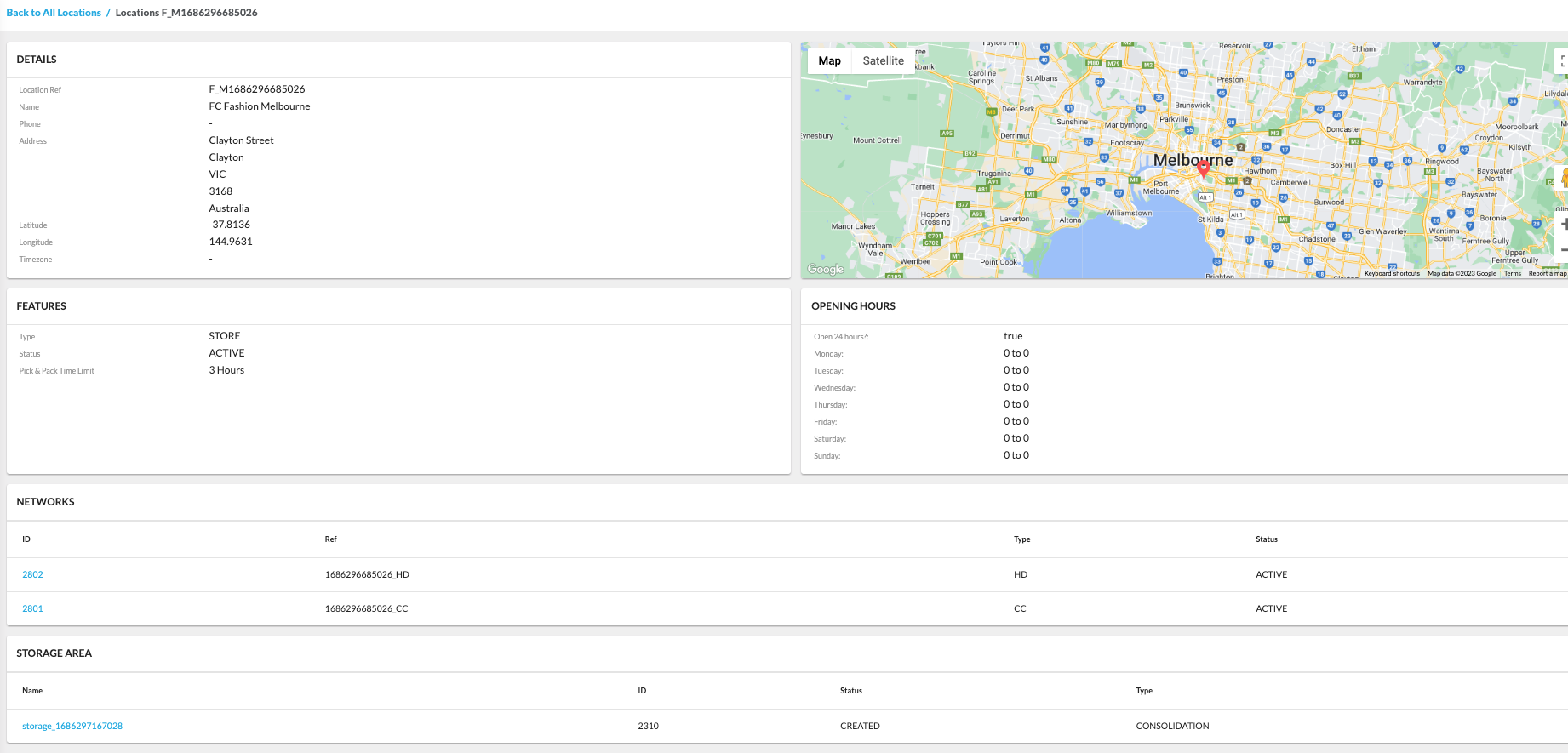
Stores are specific locations primarily utilized as sources of inventory for fulfilling customer orders. They also serve as collection points for customers to pick up their purchases, providing a seamless shopping experience. The Stores interface includes the Stores List page, where you can view the existing stores. If you click on `Ref`, it will take you to the Store Details page, which provides comprehensive information about that specific store.

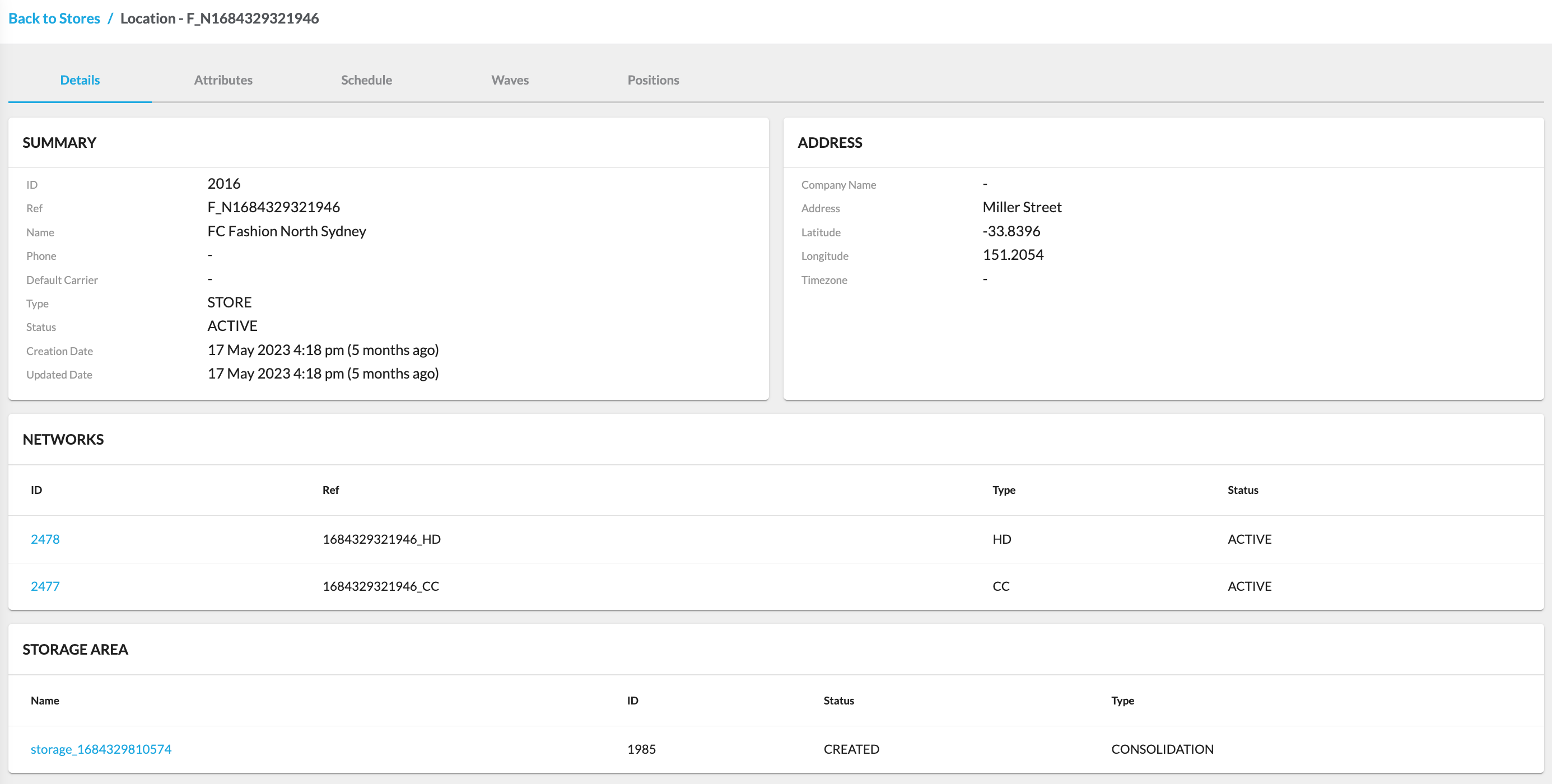


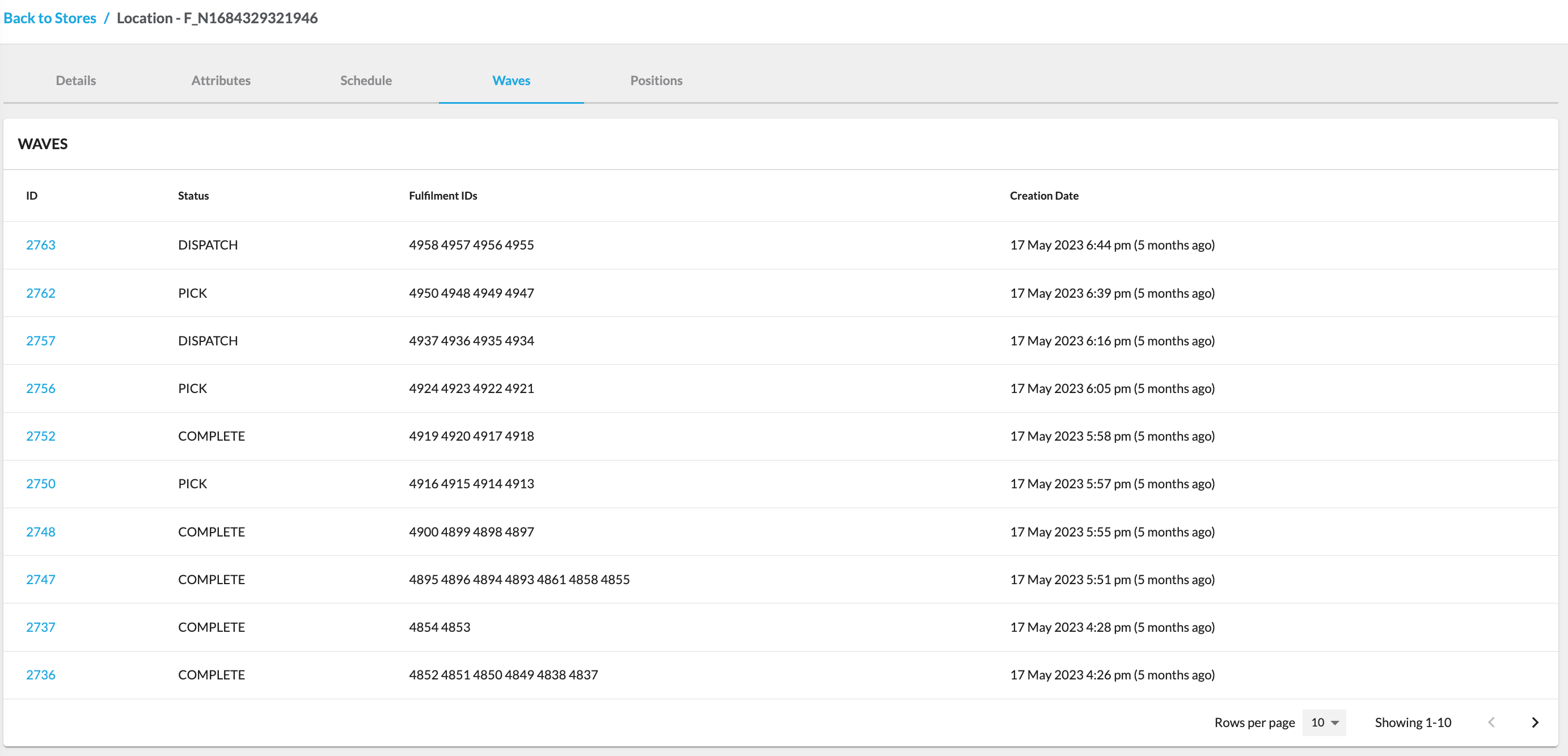
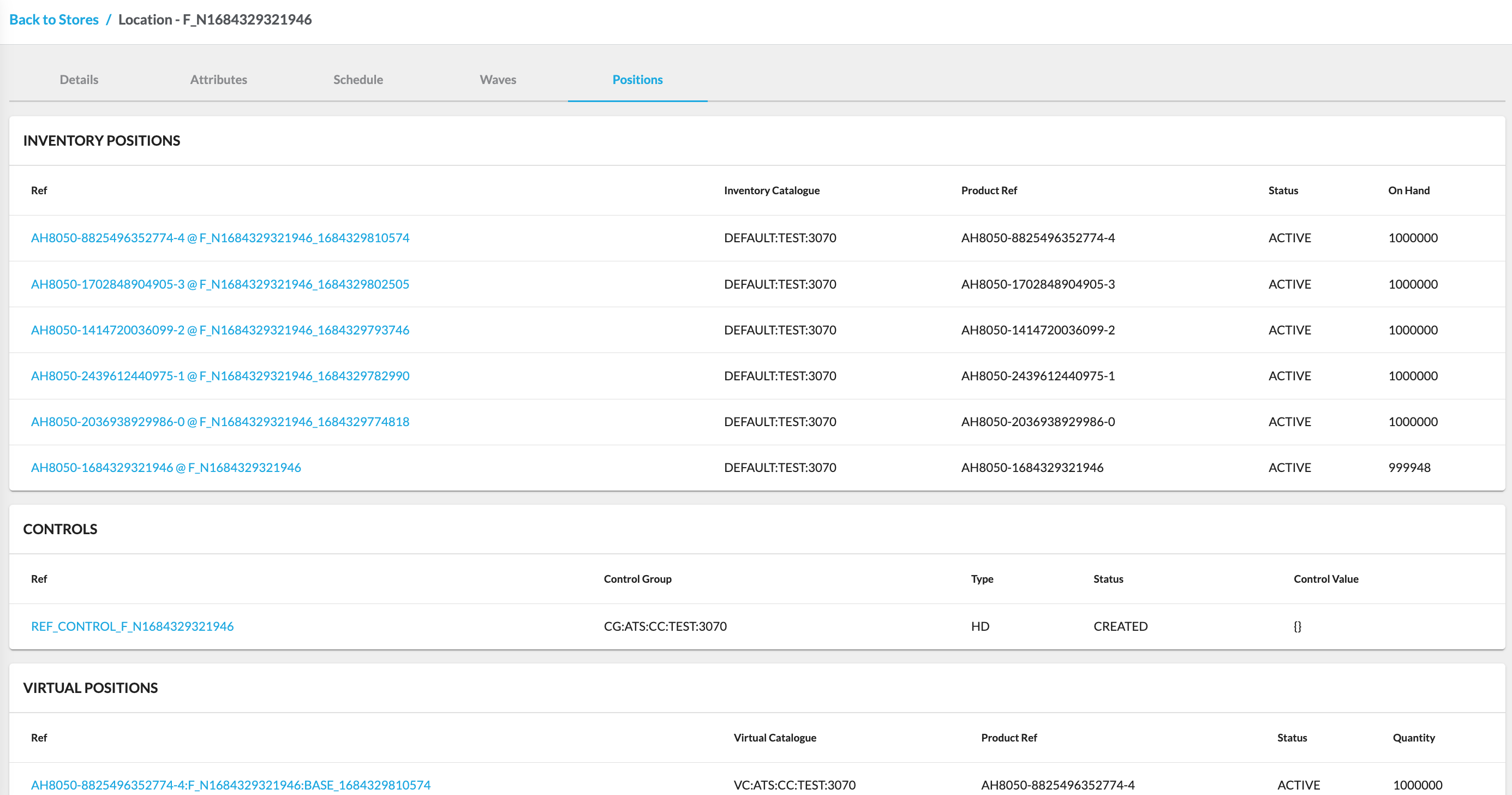
Warehouses are centralized locations dedicated to stocking inventory for order fulfillment. While they are essential for efficient supply chain operations, they are typically not designed for customer collection and are more focused on inventory management and distribution. In the Warehouses configuration, you'll find the Warehouses List page, offering a glimpse of the available warehouses. Clicking on `Ref` will seamlessly transition you to the Warehouse Details page, where you can access extensive information pertaining to that particular warehouse.

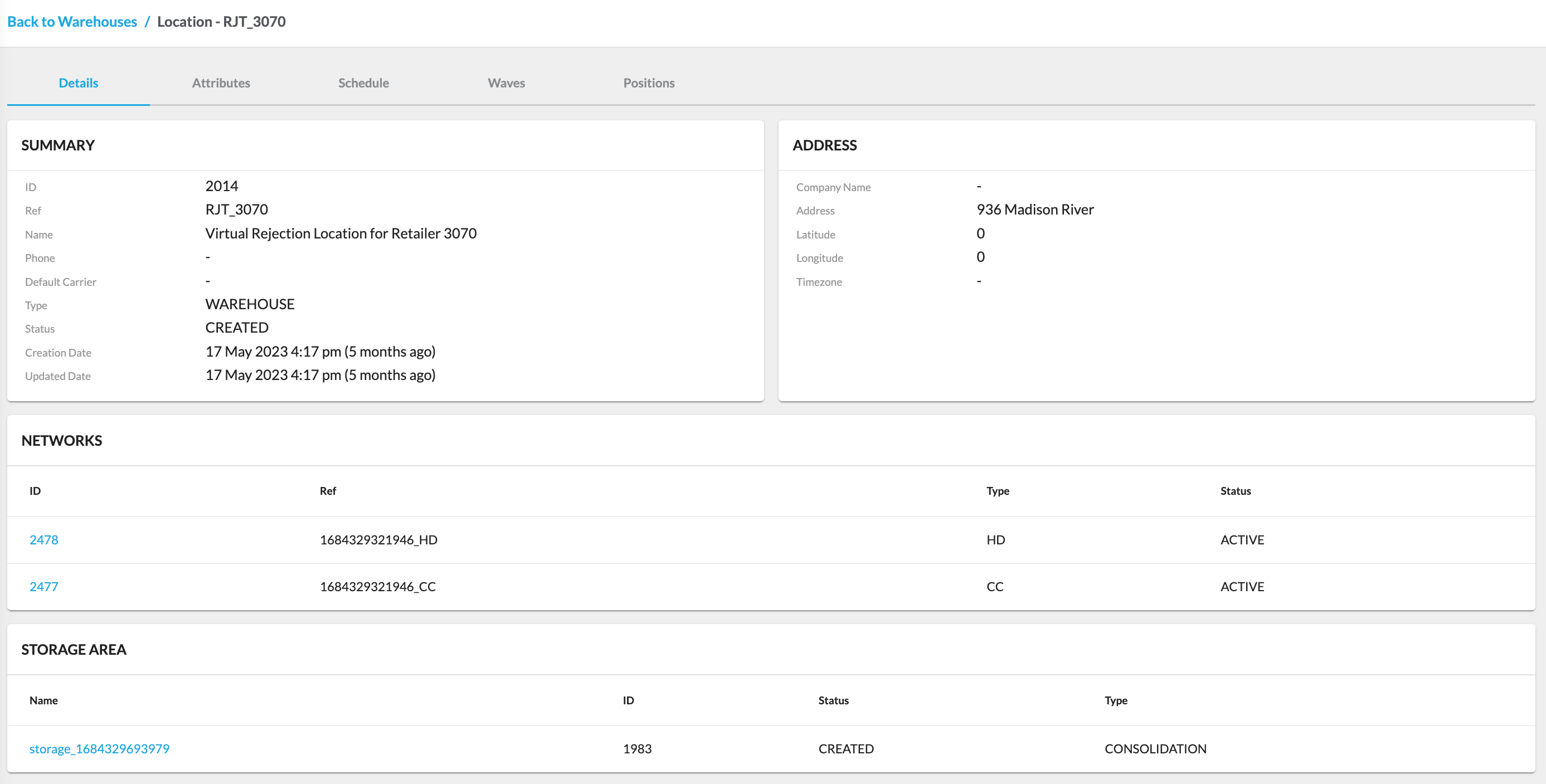



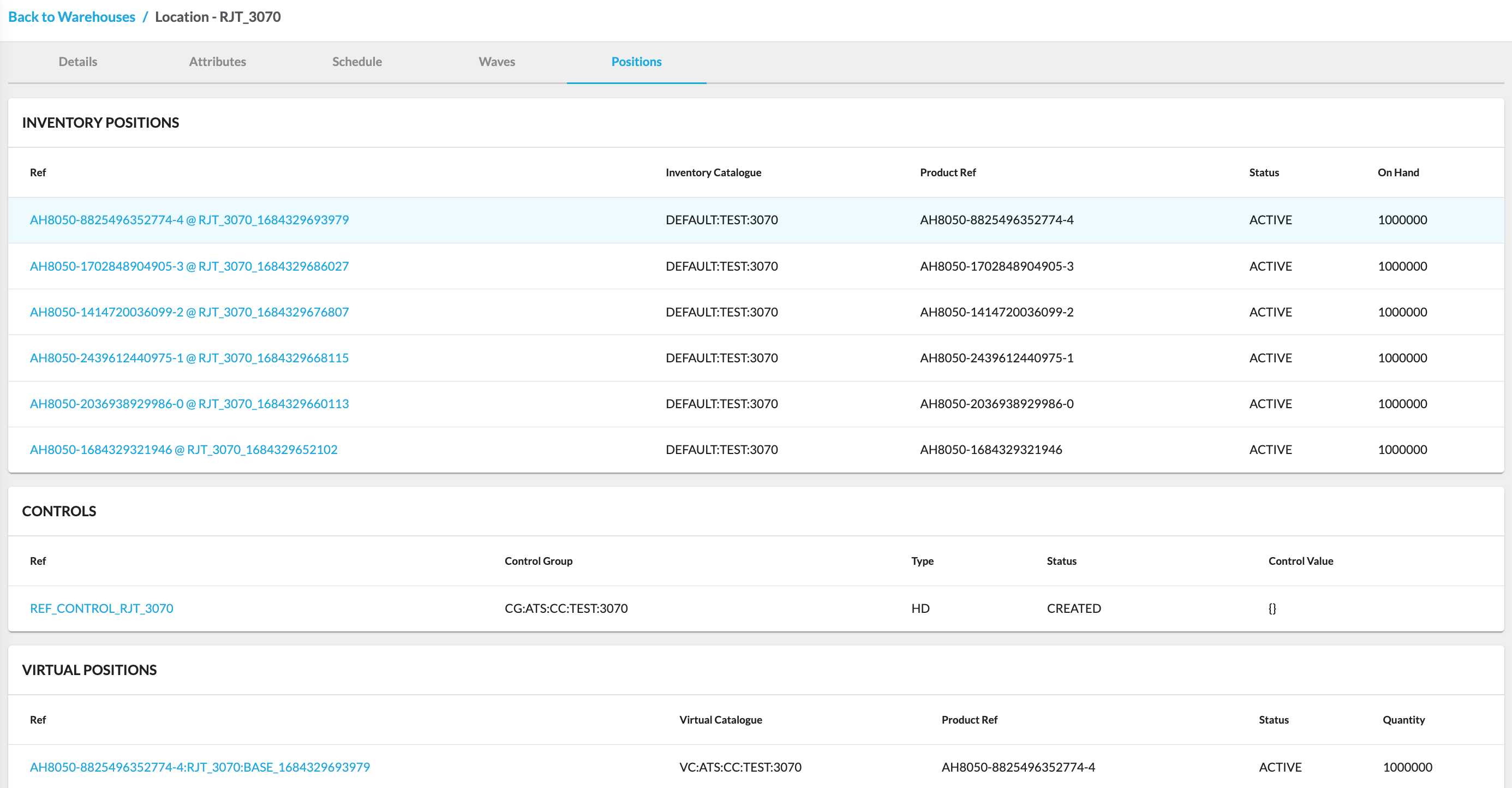
Networks are groups of locations organized into logical or geographic categories. They help you manage and optimize the operations of multiple locations, making it easier to coordinate order routing, inventory allocation, and other logistical aspects of your business. Clicking on (Network) `Ref` opens the Network Details page, where you can access comprehensive information about the specific network.

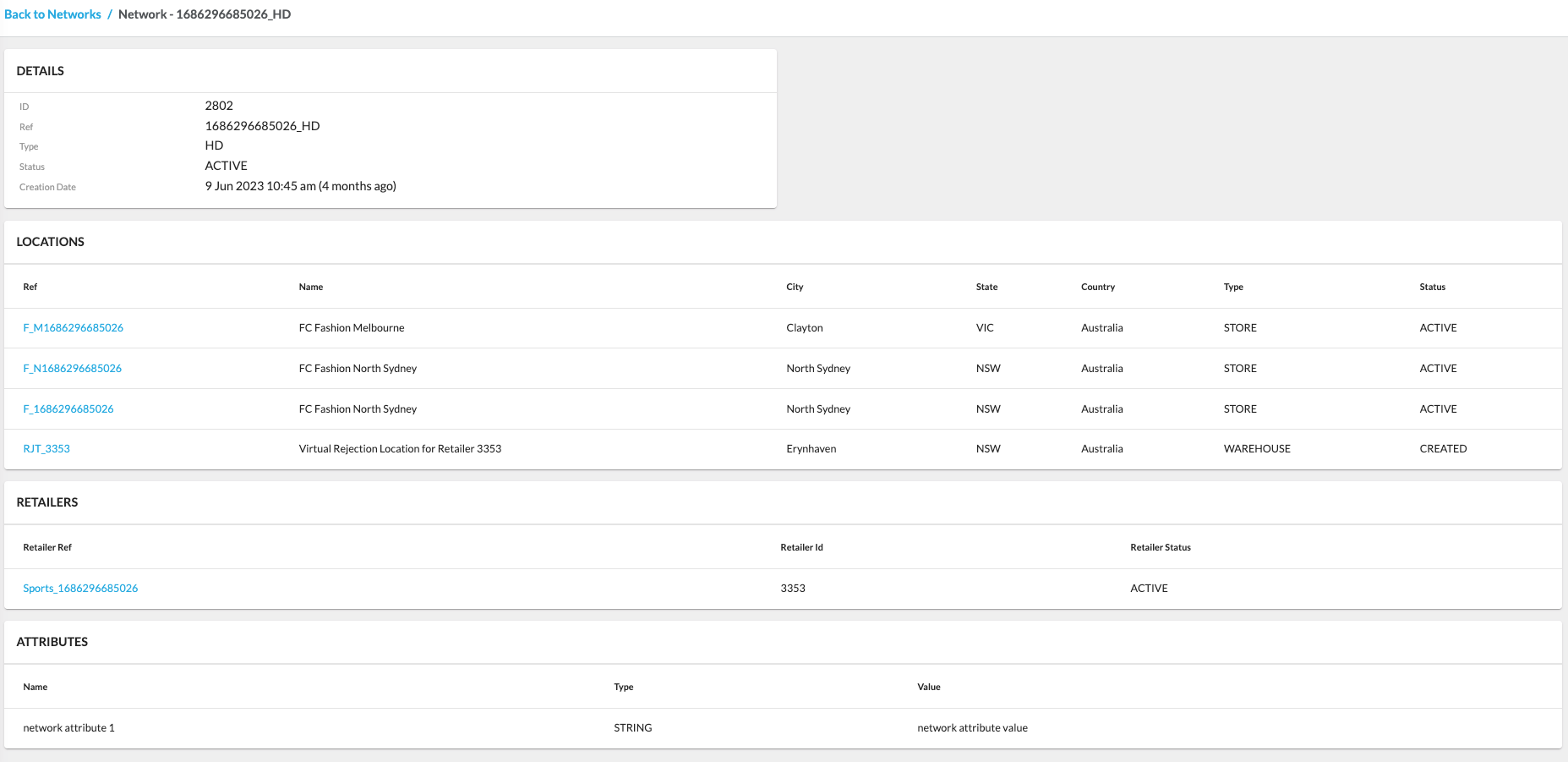
In the Fluent OMS web application, the Store interface also includes configurations for Arrivals, Collections, and Waves. These sections are related to activities performed in the Fluent Store web app:
Arrivals
The Arrivals configuration contains the list of inbound articles expected to arrive in store from other locations. A carrier is an external or internal logistics provider responsible for delivering orders from the point of fulfillment to the customer.
Clicking Article Ref opens the Article Details page, which displays detailed information about the selected article.

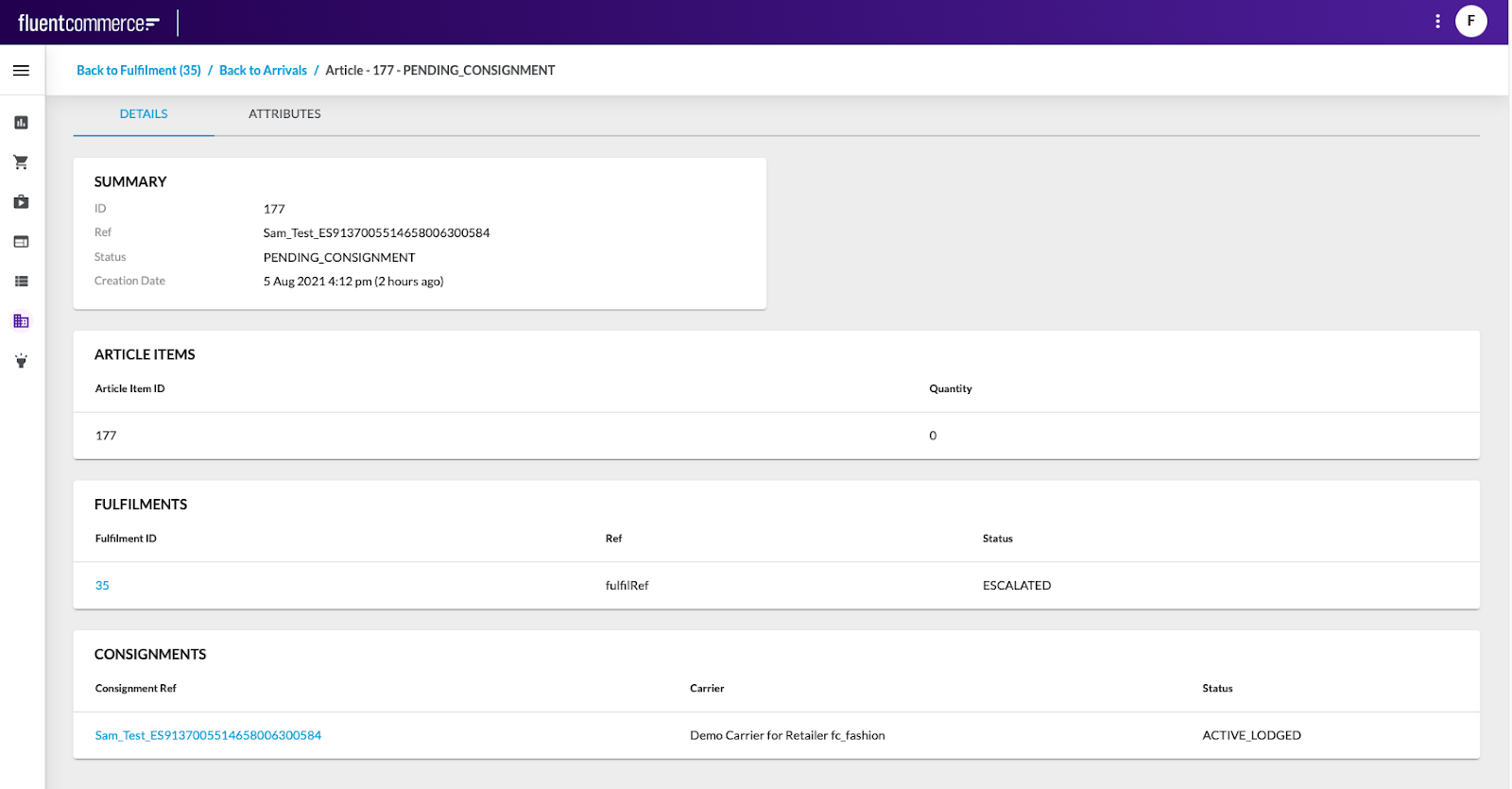
Waves
The Waves configuration contains the list of existing waves used to group orders for cost-effective and efficient fulfillment.
Clicking Wave ID opens the Wave Details page, which displays detailed information about the selected wave, including a summary card and fulfillment table.
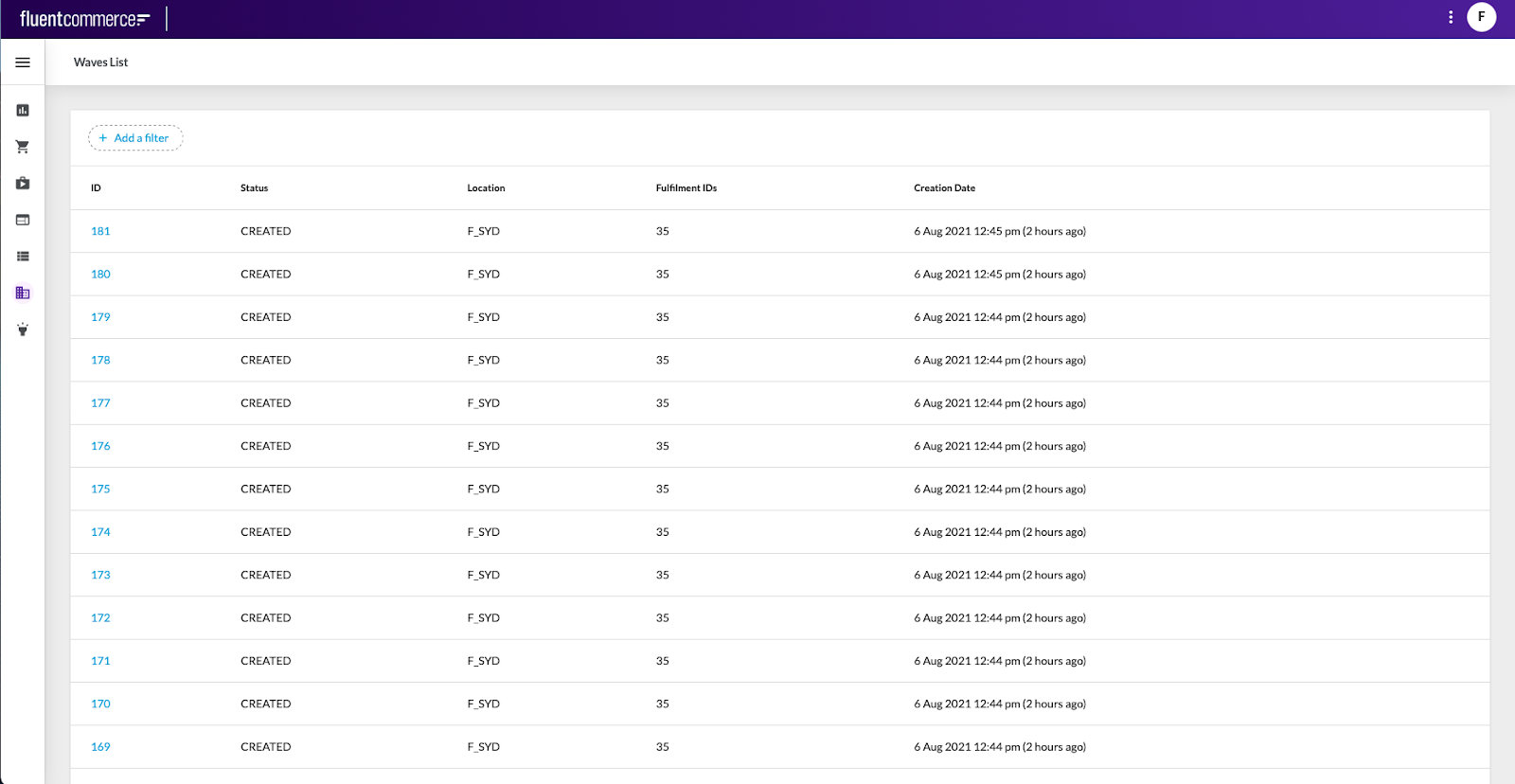

Collections
The Collections configuration contains the list of articles associated with Click and Collect and Home Delivery fulfillments.
Clicking Article Ref opens the Article Details page, which displays detailed information about the selected article.

Related content
Insights
Authors:
Fluent Commerce, Kirill Gaiduk
Changed on:
4 Aug 2025
Overview
The Insights interface is a comprehensive repository of system Events, representing occurrences or triggers within the Fluent Platform. These Events, like changes in inventory position or entity states, act as notifications, prompting specific workflows and providing a dynamic overview accessible through a user-friendly configuration featuring the Events Search Form, the Events Search Results, and the Event Details Drawer for efficient information retrieval.
Key points
- The Insights interface is a comprehensive repository providing full information about system Events, representing occurrences and triggers that prompt actions or log activities within the Fluent Platform.
- With a user-friendly configuration, the module enables efficient interaction through the Events Search Form, providing filtered event searches and responsive Events Search Results. The Event Details Drawer ensures users can seamlessly access detailed event information without losing search results or experiencing delays in page navigation.
Insights Interface
The Insights interface contains the full information about Events.
An Event represents something that has, will, or is happening within the system. An Event is typically used to ask or trigger the system to do something or log activity of what has occurred within the system.
Essentially, events are notifications within the system that various internal or external systems can consume to take further action.
Events Page
The Events page is powered with the Events Search Component.

The Events Search consists of the following sections:
Events Search Form

The Search Form contains:
- Filter input fields;
- SEARCH button;
- EXPORT button;
- CLEAR FILTERS button (hidden when no filters are applied).
Events Search Results

The list of events matching the filters criteria selected is presented in a table view.
Event Details Drawer
The drawer displays a detailed information about a specific event selected from the list of Events Search Results.
Events Export
Events export capability allows customers and partners to share event logs with support:
- A JSON file containing an array of the events' bodies is generated on EXPORT button click.
- The EXPORT button is disabled when the Events Search Results are empty.
Related content
Admin Interface
Author:
Fluent Commerce
Changed on:
25 Sept 2025
Overview
The Admin interface in the Fluent Web Apps provides comprehensive administrative capabilities to manage the entire system efficiently.
Key points
- The Admin interface helps in managing users, retailers, settings, etc.
- Depending on the configuration, it can contain any combination of the following: Retailers, Carriers, Users, Roles and Permissions, and Settings.
Admin Management in Fluent Web Apps
Manage Users
User management is critical to any application seeking a personalized and secure user experience.
For more details about the specifics of the create and edit users features, check out the following guide.
Manage Roles and Permissions
With roles and permission management, administrators can easily grant or restrict access to the application based on the user’s role or job function. By defining different roles and permissions, administrators can ensure that users only have access to the functionalities and data they need to perform their job function.
For more details about the specifics of creating and editing roles and permissions, check out the following guide.
Manage Settings
Setting management allows you to adjust the application to your business needs.
For more details about the specifics of the create and edit settings features, check out the following guide.
Retailers
Retailers configuration contains the list of existing retailers. Clicking (Retailer) `ID` opens the Retailer Details page, which displays detailed information about the particular retailer.


Carriers
The Carriers configuration is available only in the reference Fluent OMS Web App version.
The Carriers configuration contains the list of existing carriers. A carrier is an external or internal logistics provider responsible for delivering orders from the point of fulfillment to the customer. Clicking Carrier Ref opens the Carrier Details page, which displays detailed information about the selected carrier, including ID, Type, Status, creation dates, consignment details, and attributes.


Users
The Users interface contains the Users List page, which displays the list of existing users. This interface provides a view of all users within the Retailer, including their username, first and last name, type, roles, and status. This list is crucial for administrators to manage user access and ensure that users have the appropriate permissions to perform their tasks within the app.
Clicking the `Username` opens the User Details page, which displays detailed information about the particular user.
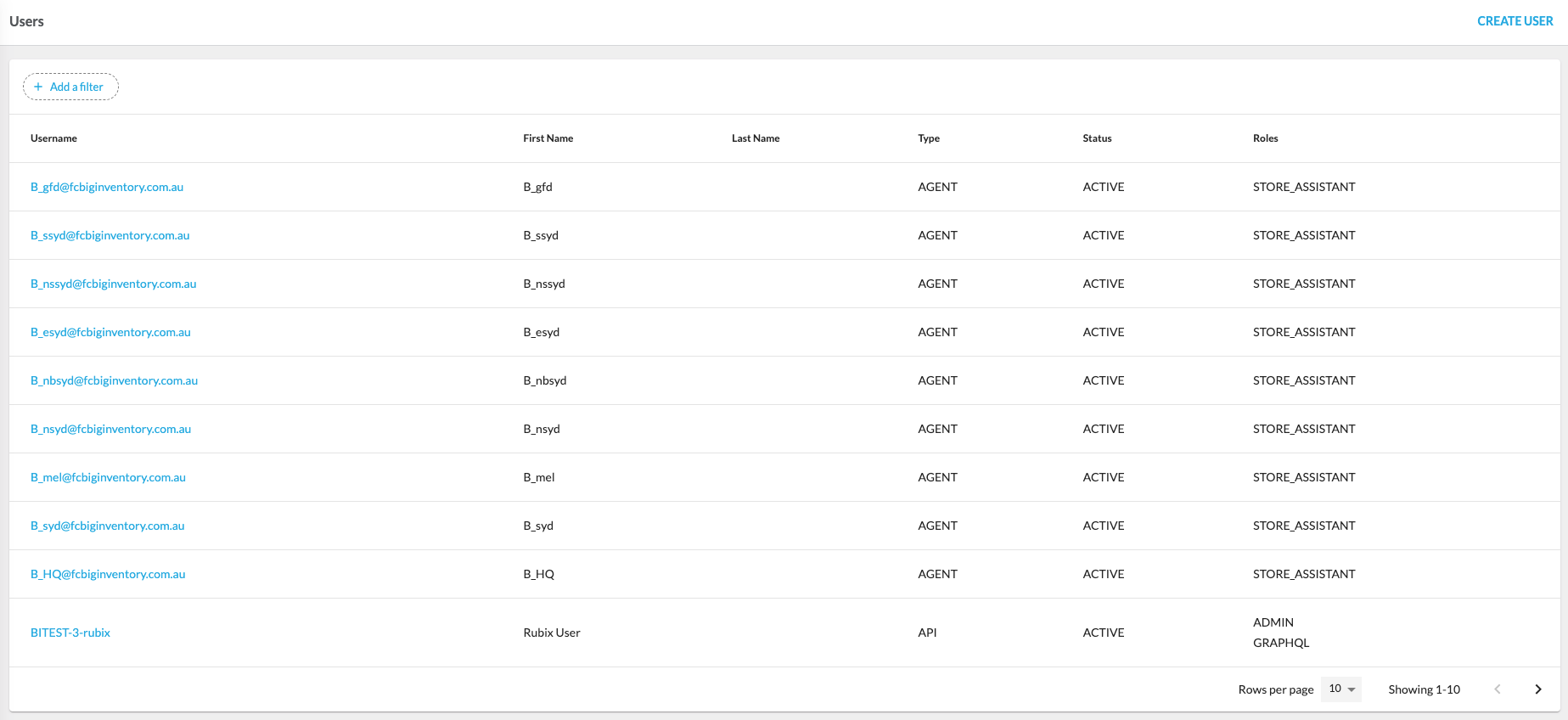
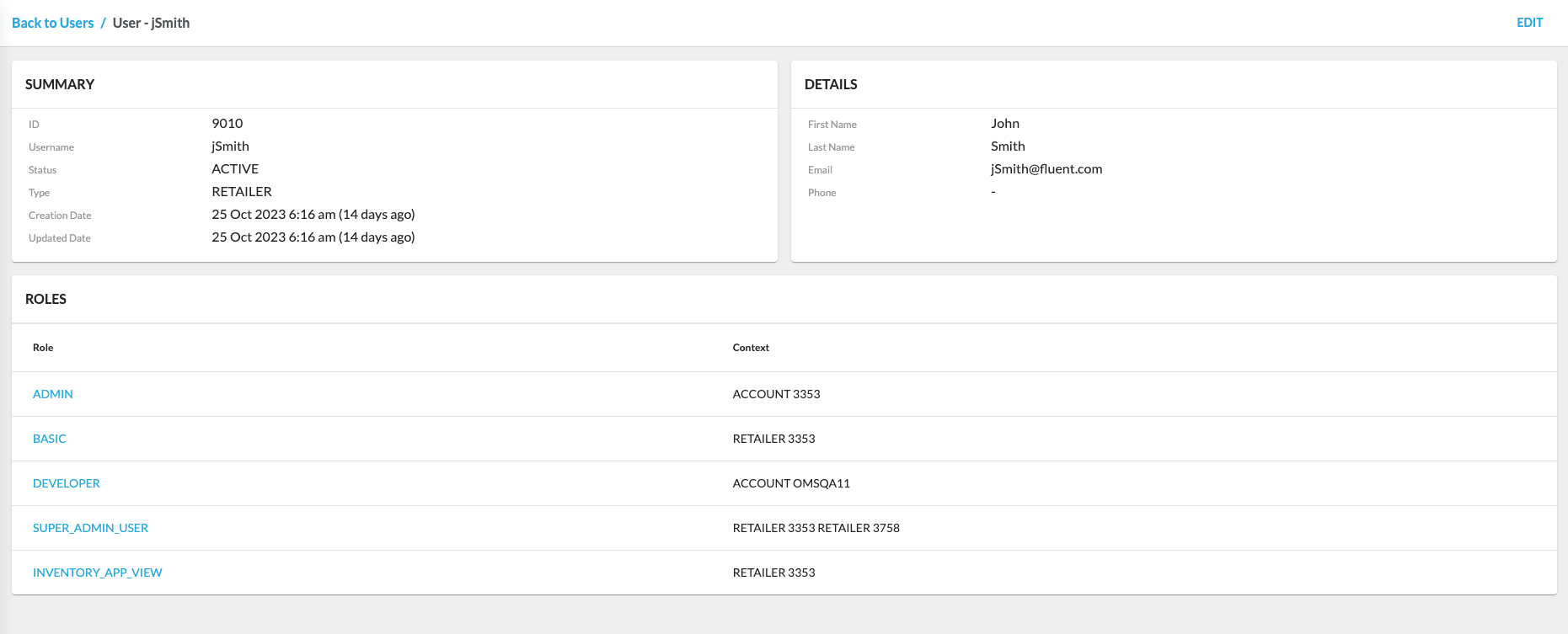
Roles & Permissions
Roles and permission management allow control of user access to different functionalities and data.
Multiple roles allow users to perform any actions within any or all of the roles assigned to them. Roles and permission management enhance security and help a Retailer manage a user base efficiently.
The Roles & Permissions configuration contains the Roles & Permissions page, which displays each role’s list of permissions. Clicking `Role Name` opens the Role Details page, which shows detailed information about the particular user role.
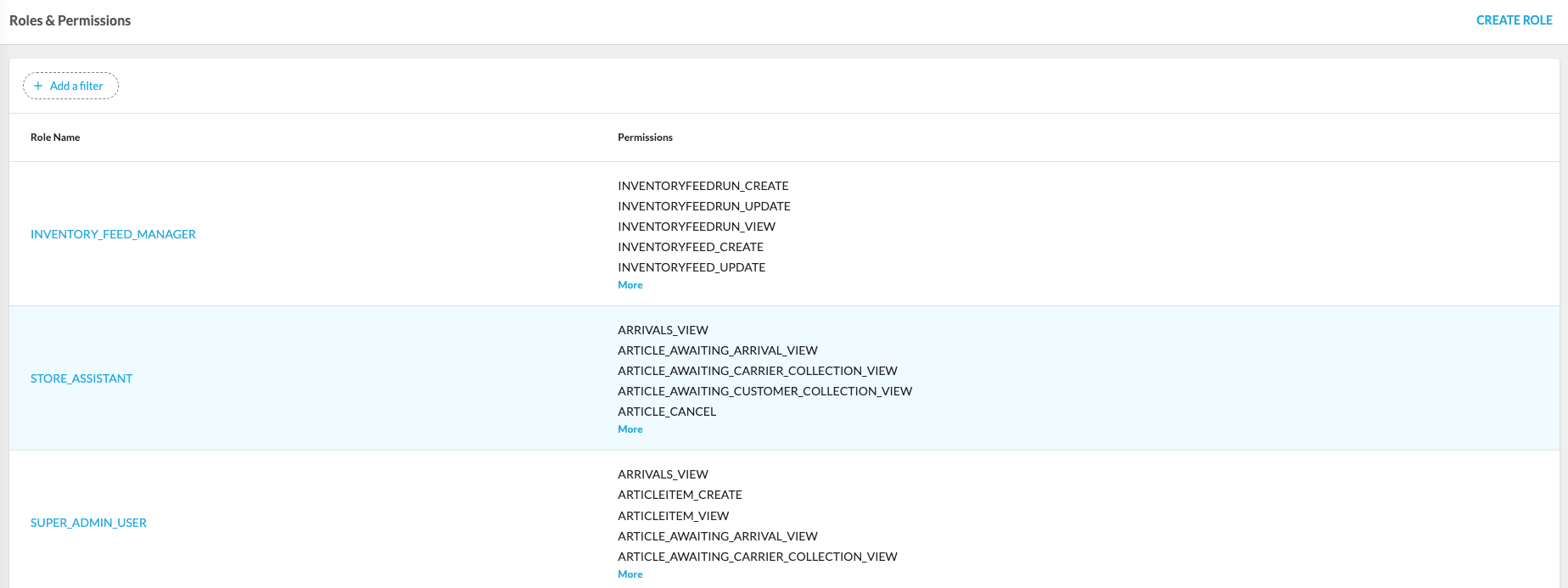

Settings
The Settings interface allows business rules management by configuring settings on different levels, e.g., ACCOUNT or RETAILER. Settings configuration contains the Settings List page, which displays the list of settings. Clicking `Setting Name` opens the Setting Details page, displaying detailed information about the particular setting.
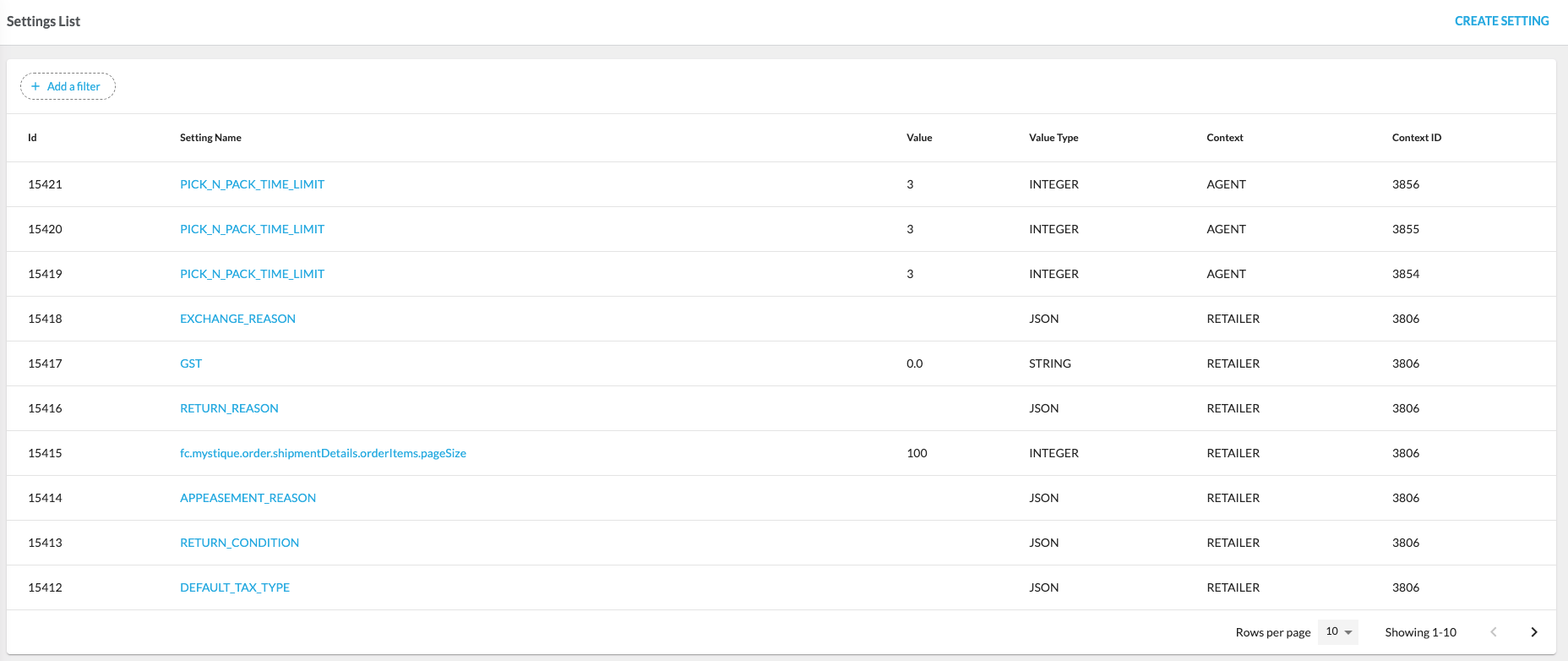

Sourcing Profiles
The Sourcing Profiles page in the Admin interface provides a centralized view of all configured profiles. It allows users to quickly see each profile’s current configuration, status, and history. From here, profiles can be opened for editing, version history can be reviewed, or a draft or inactive profile can be activated.
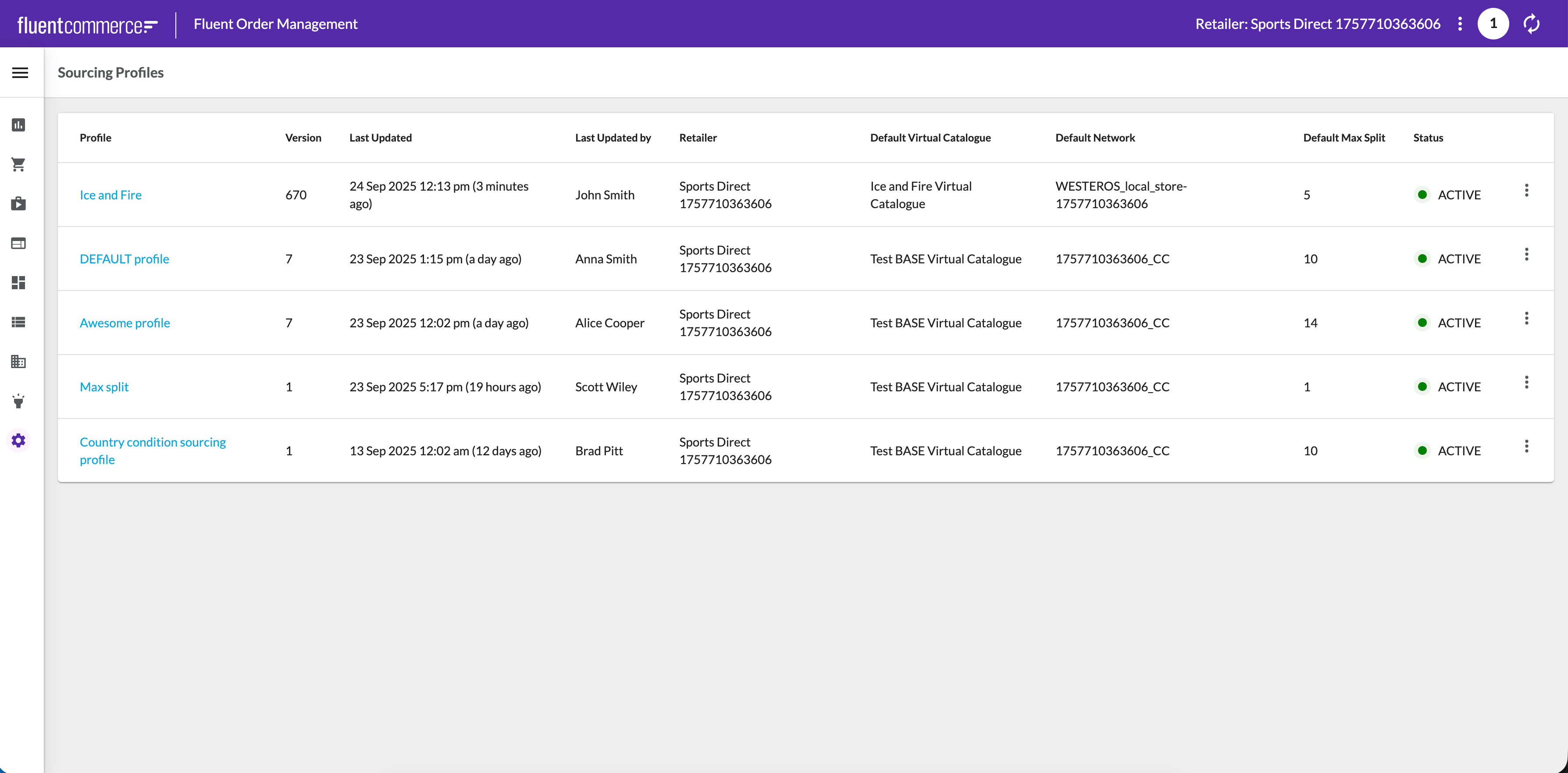
When a profile is opened, the Profile Details view is displayed. This view combines a summary of key attributes (such as default catalog, networks, and max split) with the profile’s current status and version information. Strategies are shown in the order they are executed, with primary and fallback strategies clearly distinguished for clarity.
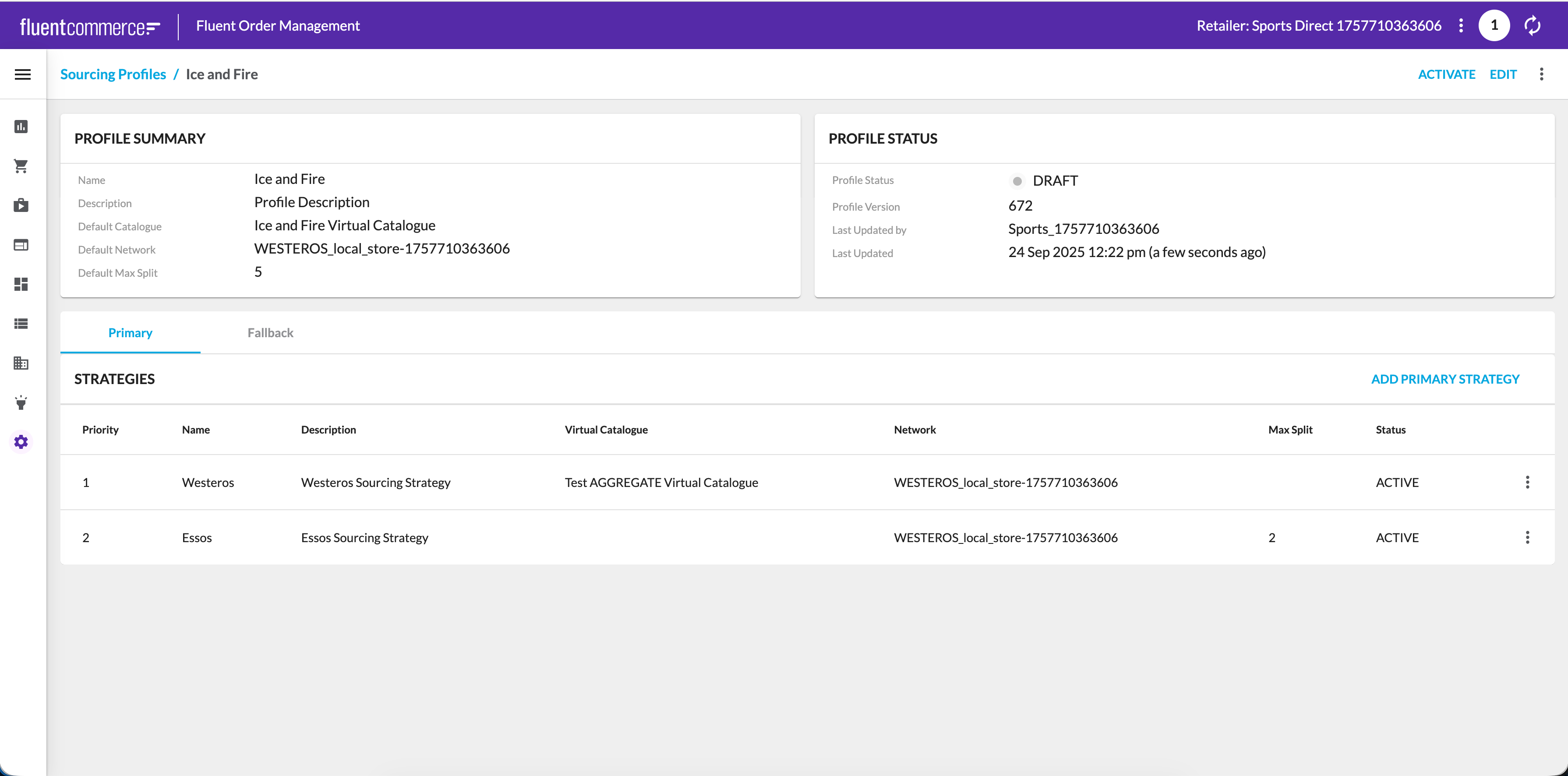
For a deeper overview of configuring and managing profiles, please see the full article on Sourcing Profiles.
